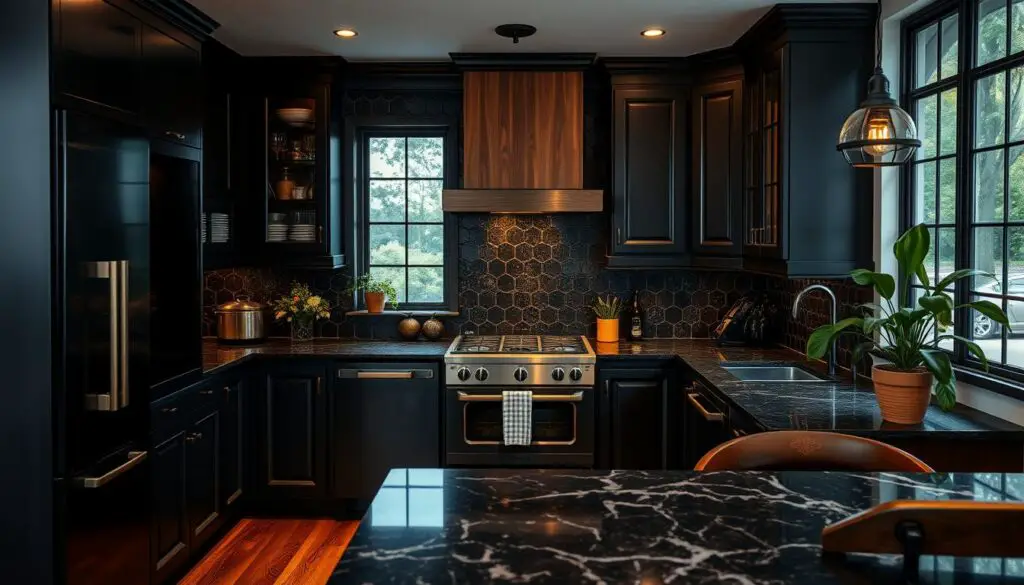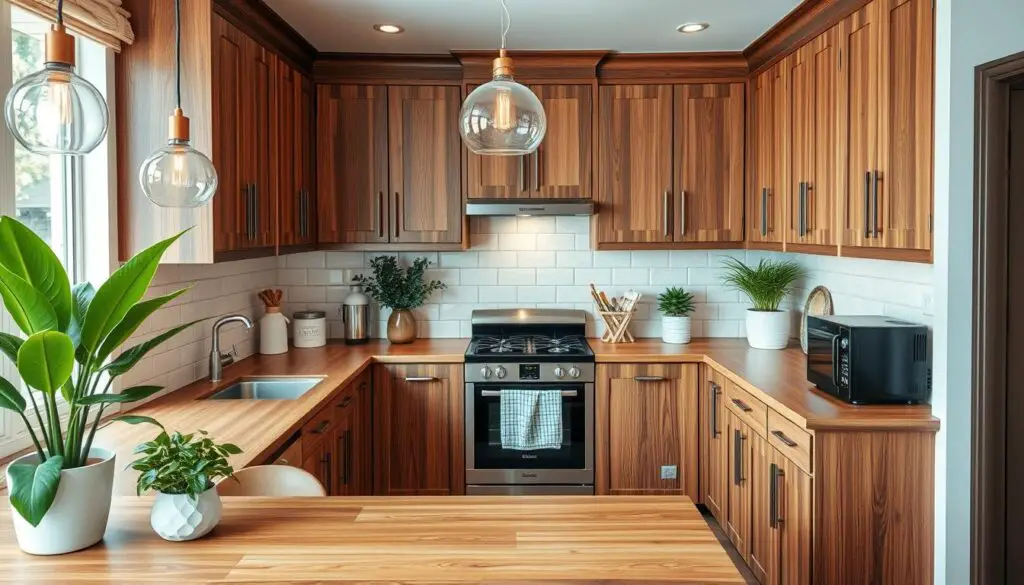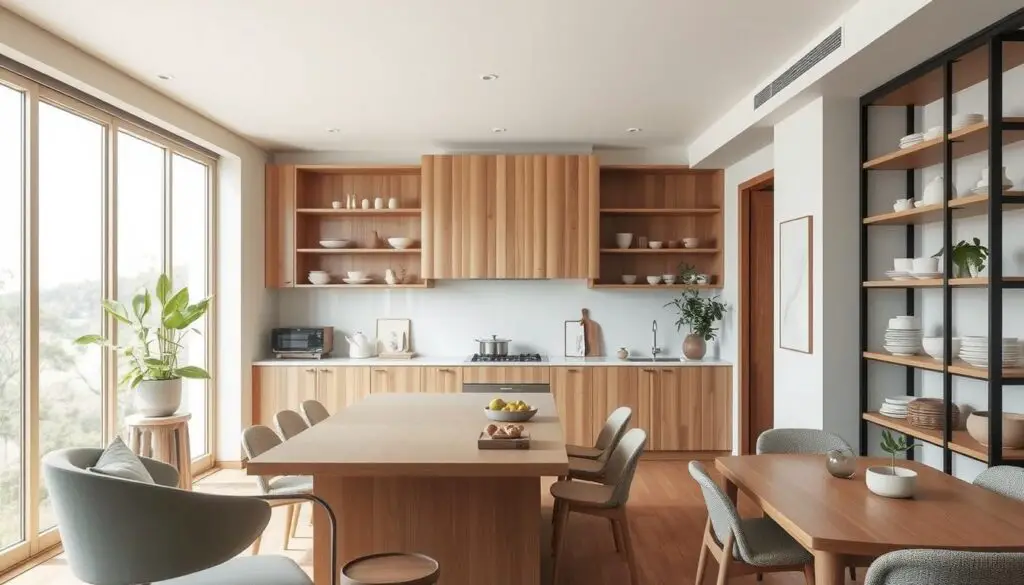
Japandi style blends Japanese and Scandinavian design, offering a fresh take on kitchen decor. It focuses on simplicity, function, and a connection to nature. This creates a peaceful and welcoming space. Whether you’re redoing your kitchen or just want to add a Japandi touch, these 20 ideas will help you create a modern, calm kitchen.
Japandi design values natural materials, clean lines, and a tidy space. It uses soft colors like whites, beiges, and greys for a soothing feel. Light wood, bamboo, and stone add texture. Black accents add a touch of contrast, keeping the look simple.
In a Japandi kitchen, function is key. Storage and appliances are hidden but easy to use. Handmade tiles and unique lighting fixtures add beauty and practicality. This makes cooking a mindful and enjoyable experience.
Follow japandi kitchen ideas to create a space where simplicity meets nature. These decor ideas will help you make a Japandi kitchen that’s both stunning and useful.
Understanding Japandi Design Principles
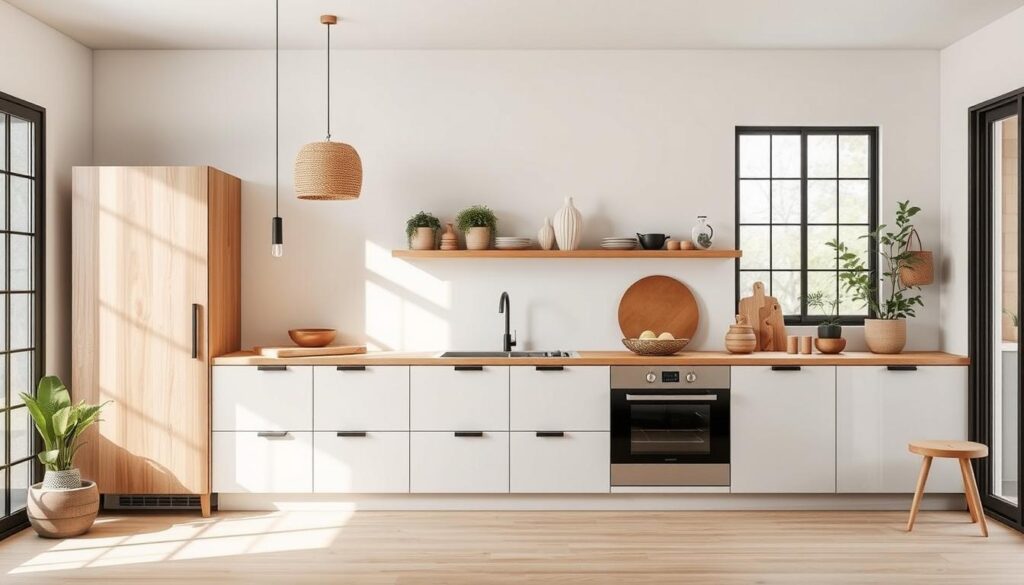
Japandi is a mix of Japanese minimalism and Scandinavian functionality. It’s a design trend that’s gaining popularity. It focuses on simplicity, natural materials, and connecting with nature.
What is Japandi Style?
Japandi style combines Japan’s wabi-sabi philosophy with Scandinavia’s cozy hygge. It values the beauty of imperfection. It uses natural materials like wood, stone, and rattan to create beautiful and functional spaces.
The Balance of Aesthetics and Functionality
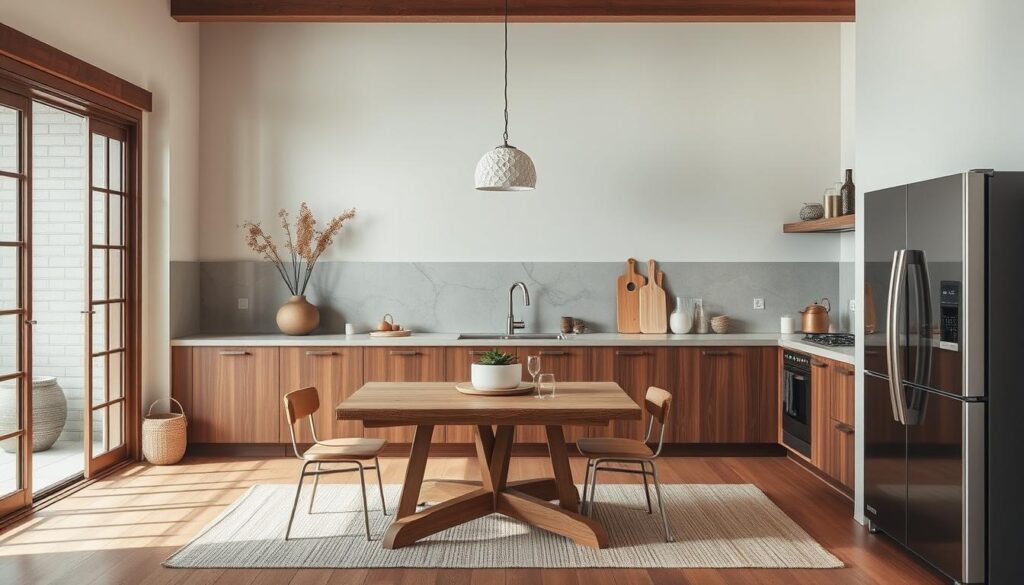
Japandi design finds a perfect balance between looks and use. It makes sure every part of a space has a purpose and feels calm. It uses clean lines, simple forms, and minimalist furnishings that fit well with the natural materials kitchen look.
Color Palettes to Consider
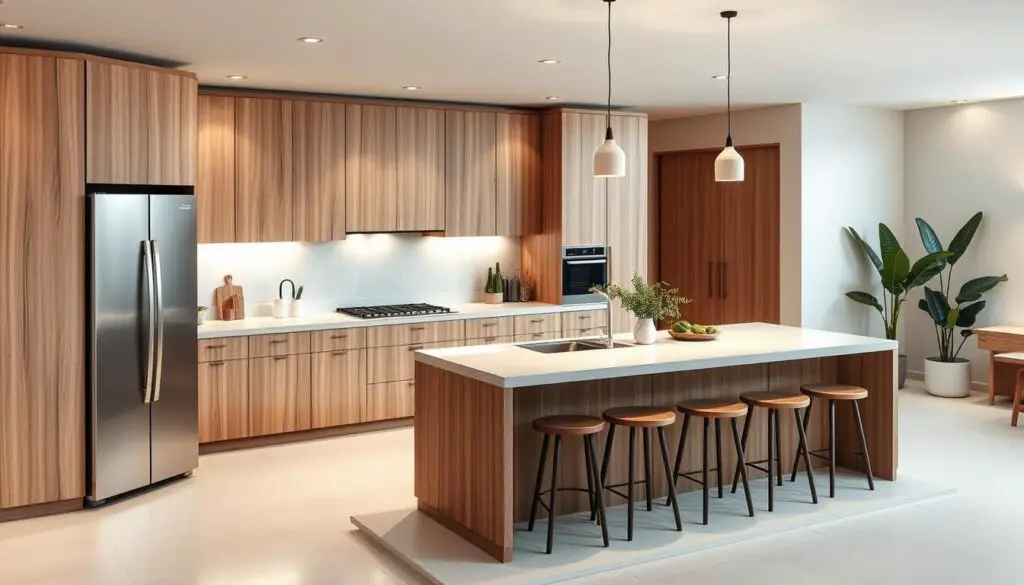
- Soft, earth tones color palette like whites, beiges, and grays
- Muted, natural hues that complement the japanese-scandinavian fusion style
- Occasional pops of color, such as muted blues, greens, or ochres, to add visual interest
By following Japandi design, homeowners can make welcoming, tranquil spaces. These spaces blend form and function beautifully. They let people enjoy the beauty of simplicity every day.
Key Features of a Japandi Kitchen
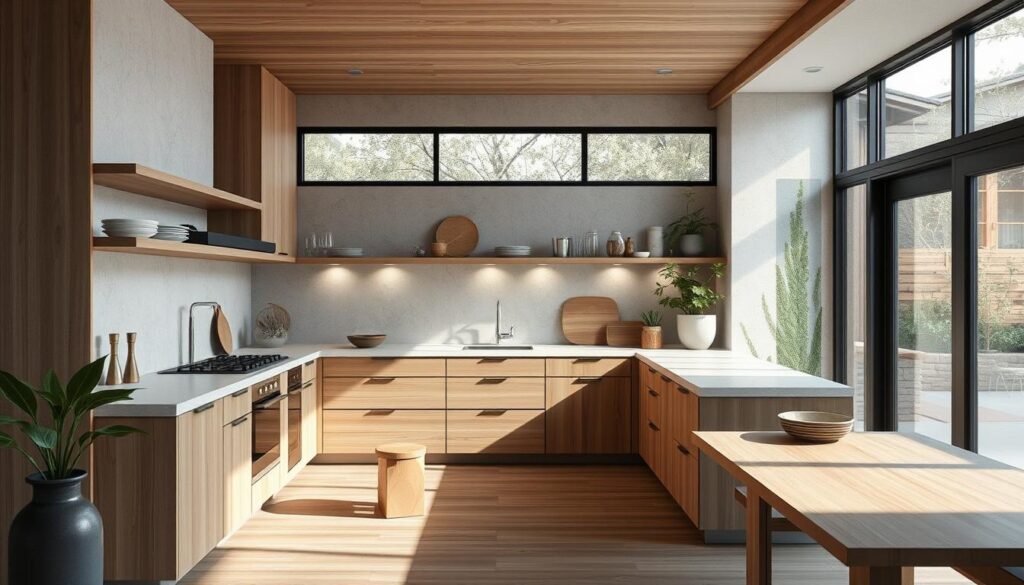
Japandi kitchens mix Japanese calm with Scandinavian simplicity. They feature open spaces, minimal designs, and lots of natural materials like wood, stone, and bamboo.
Open Spaces and Minimalism
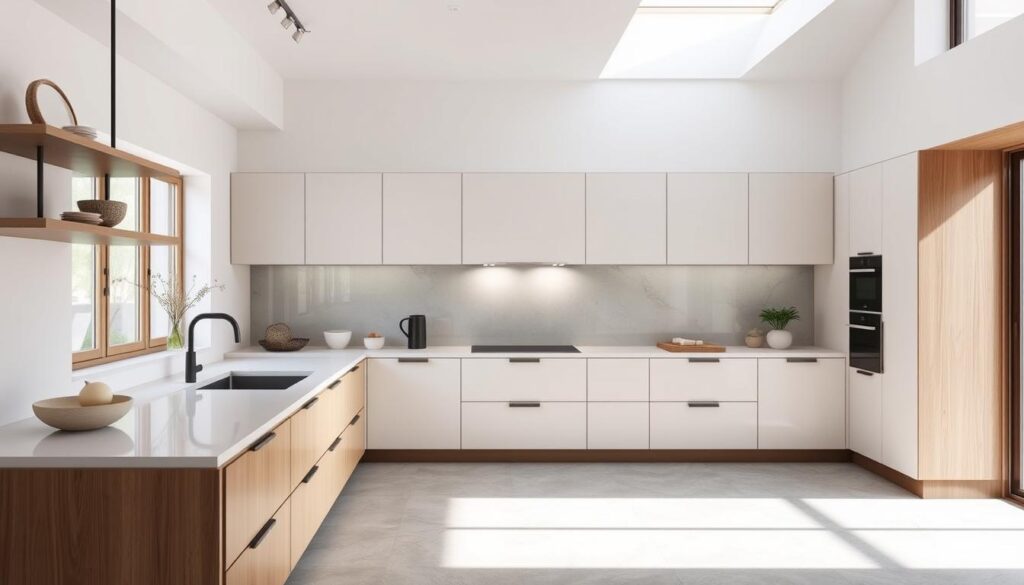
Japandi kitchens focus on being open and free of clutter. They have clean lines, no handles on cabinets, and smart space use. This makes the kitchen feel calm and simple.
Appliances blend into the cabinets, adding to the minimalist vibe.
Natural Materials and Textures
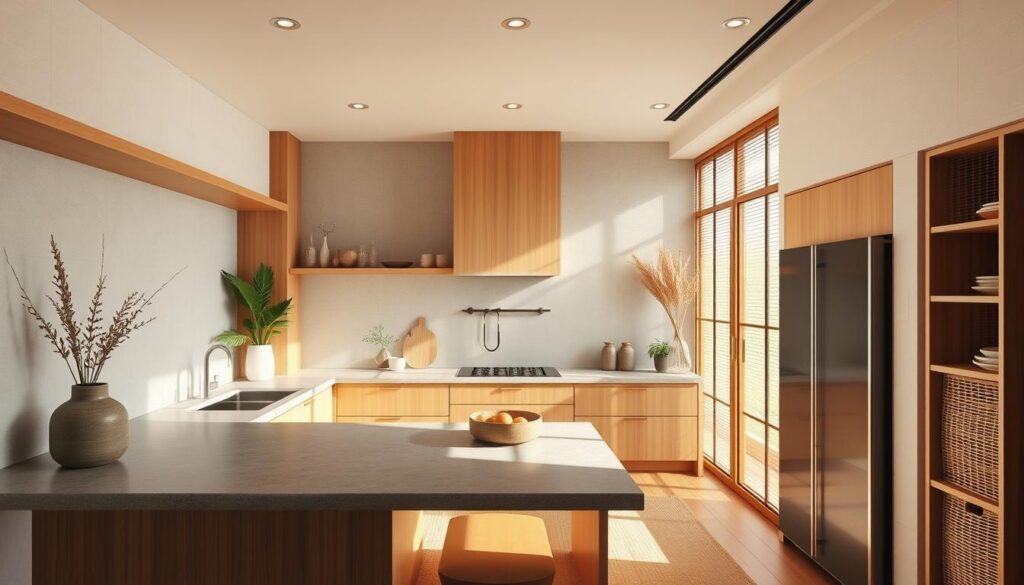
The Japandi look loves natural materials. You’ll find warm wooden accents, stone countertops, and woven or bamboo elements. These add warmth and interest, fitting the minimalist kitchen design.
Using natural materials kitchen is key to Japandi style.
Clean Lines and Simple Forms
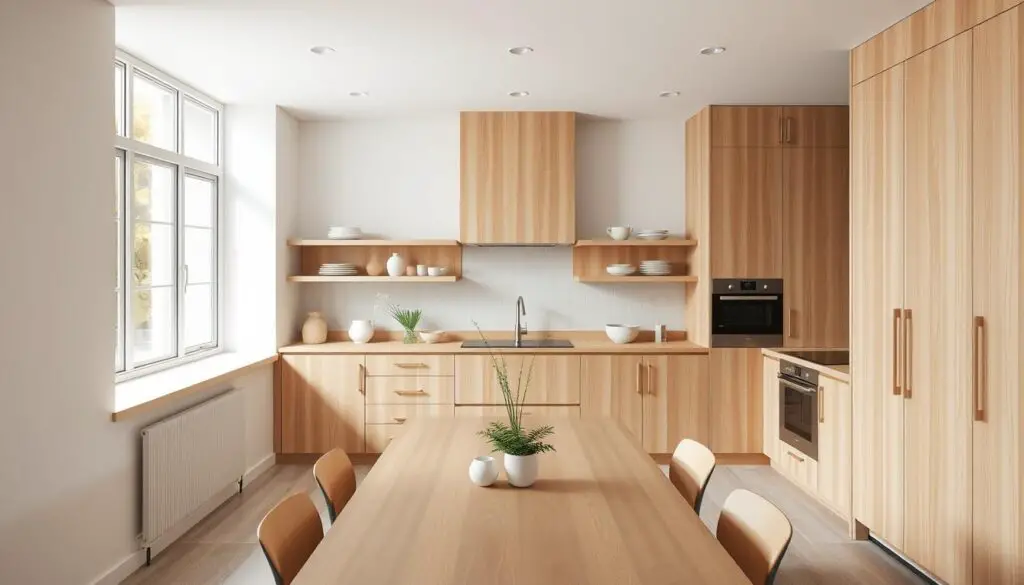
Japandi kitchens have clean lines and simple shapes. They choose furniture and fixtures for their simplicity and usefulness. This creates a space that looks good and works well.
Light wood cabinets, often in soft colors, highlight the natural beauty of the materials.
Japandi kitchens blend Japanese and Scandinavian design for a peaceful, stylish space. They focus on open areas, natural materials, and clean lines. This makes them both beautiful and practical.
Color Schemes for Your Japandi Kitchen
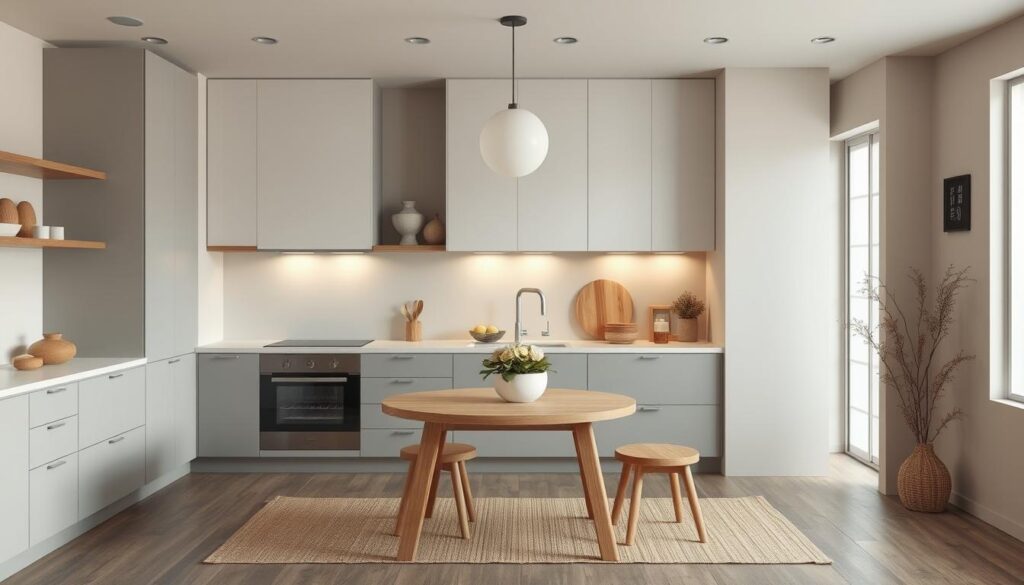
Designing a Japandi kitchen focuses on the color palette. It’s all about finding the right mix of modern simplicity and natural warmth. Earthy tones and soothing pastels help create a calming, zen-like feel.
Earthy Tones and Pastels
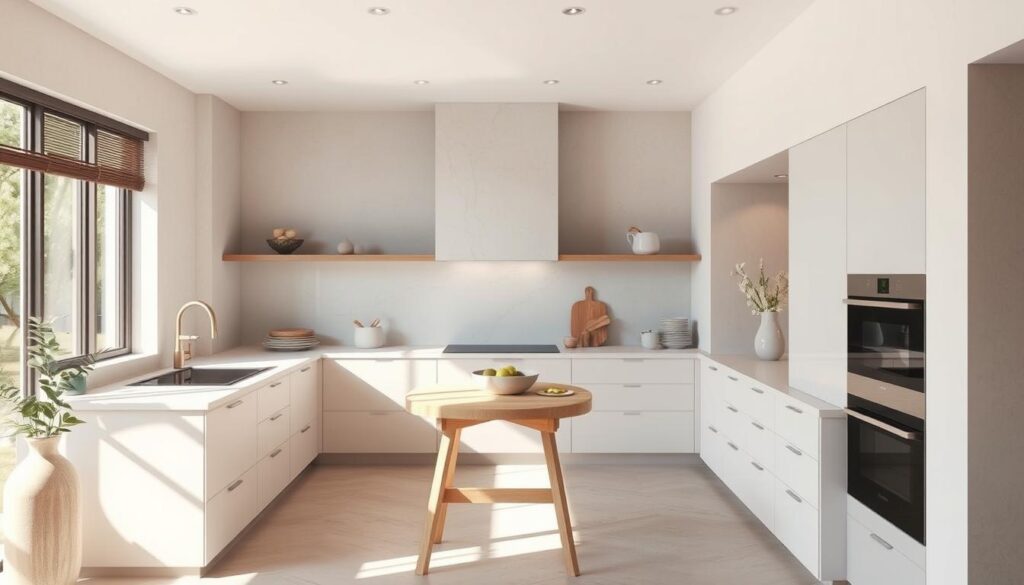
Japandi kitchens often start with soft whites, beiges, greys, and muted earth tones. These colors provide a serene background that highlights materials like wood, stone, and ceramics. Adding soft pastels like whisper-white, bamboo beige, and zen grey enhances the tranquility and opens up the space.
Accent Colors to Enhance Design
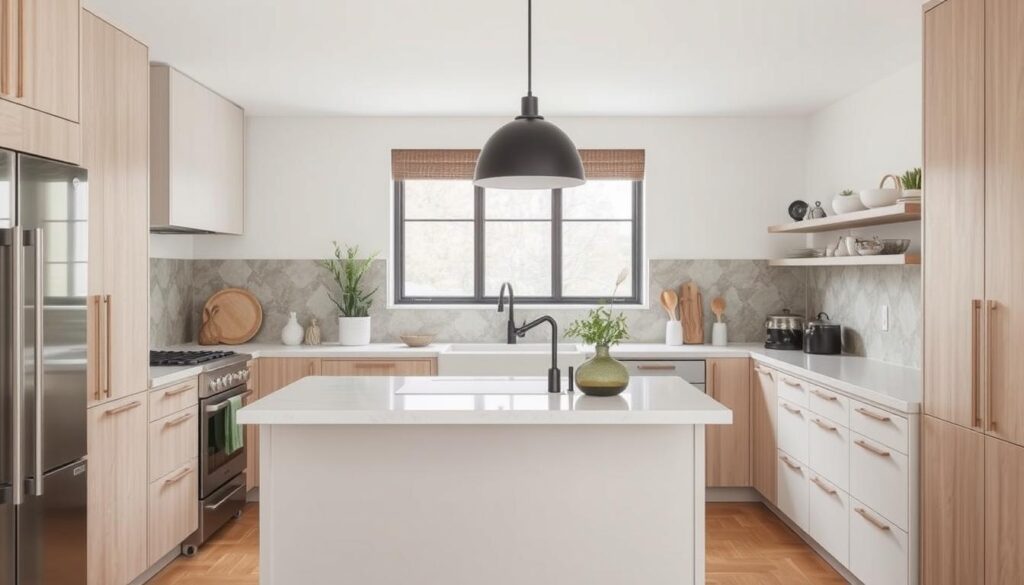
While neutrals are key, Japandi design also uses accent colors for depth. Muted blues, greens, or black can be used in small details like hardware or decor. These accents add interest without overwhelming the calm atmosphere.
Combining Warm and Cool Shades
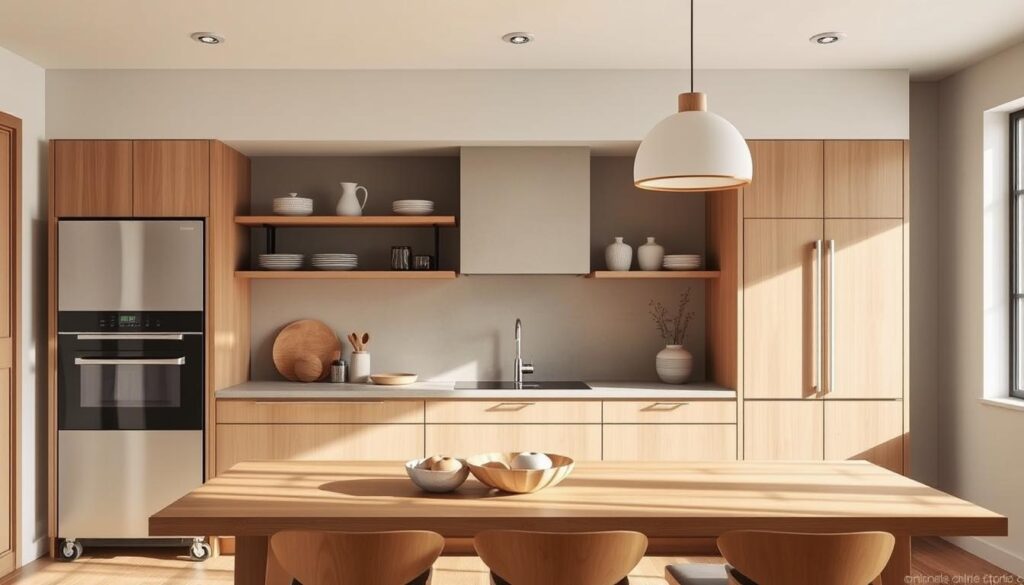
Japandi color schemes mix warm and cool tones for balance. Warm browns and beiges meet cooler greys and whites. This mix adds depth and reflects the blend of Japanese minimalism and Scandinavian coziness.
The goal of a Japandi kitchen’s color palette is calm and tranquility. By blending earthy tones, pastels, and subtle accents, you create a space that embodies minimalist, zen-inspired design.
| Color | Percentage of Color Palette | Description |
|---|---|---|
| Neutral Whites | 7.5% | Emphasize light and space illusion, crucial for Japandi kitchens with clean lines and open layouts. |
| Soft Greys | 5% | Embody tranquility and sophistication, inspired by pebble gardens in Kyoto. |
| Earthy Browns | 2.5% | Create a welcoming atmosphere, integrating with clean lines and natural elements in Japandi spaces. |
| Greens | 2.5% | Provide a subtle accent to complement the natural materials and overall minimalist design. |
| Black Accents | 2.5% | Serve as a refined contrast, highlighting the clean lines and contemporary elements of Japandi kitchens. |
| Muted Blues | 2.5% | Offer a calming, natural-inspired accent that blends seamlessly with the earth tones and pastels. |
| Pastel Pinks | 2.5% | Provide a soft, feminine touch that complements the overall zen-inspired aesthetic. |
The data shows a focus on neutral and natural colors. Only a few vibrant accent colors are mentioned. This highlights the serene and minimalist vibe of the Japandi color palette.
Essential Decor Elements
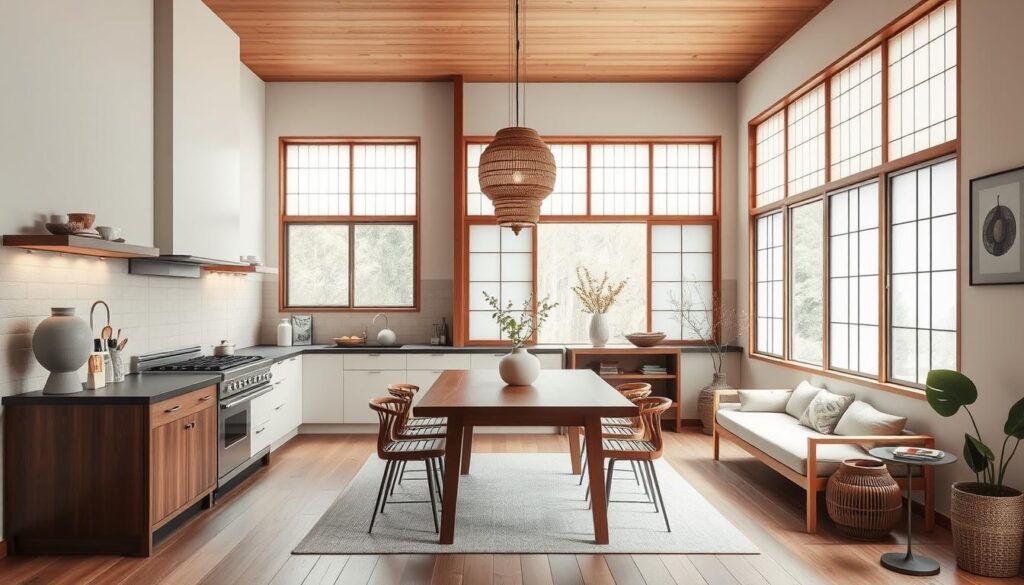
Creating a Japandi-inspired kitchen is all about the decor. Furniture, lighting, and window treatments are key. They help make the space feel zen-like.
Furniture Choices for a Japandi Vibe
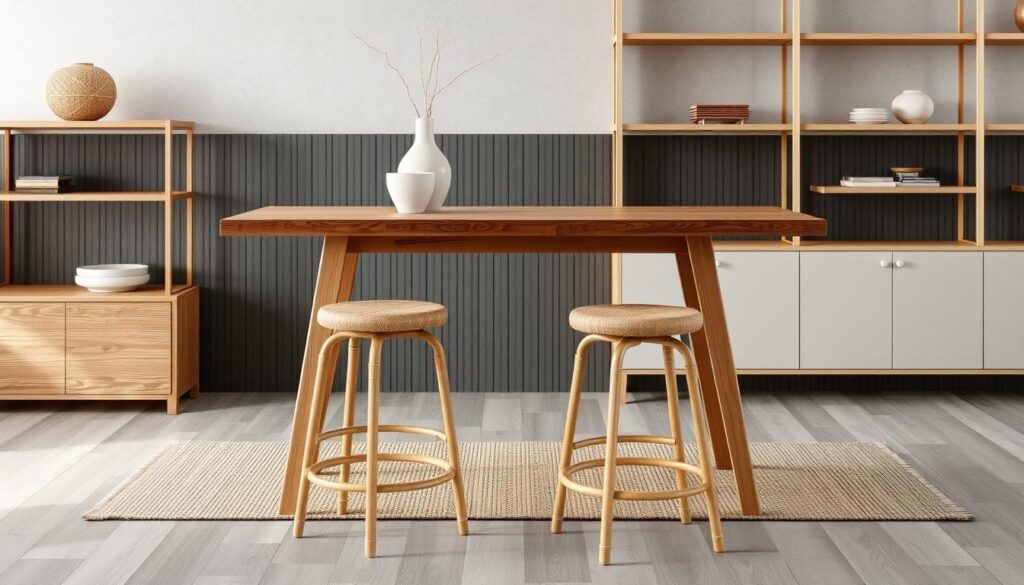
Japandi design loves clean lines and natural materials. Look for wooden dining tables, bamboo barstools, and simple shelving. These pieces should be both useful and beautiful, blending japanese-scandinavian fusion and zen-inspired interiors perfectly.
Lighting Fixtures that Complement the Style
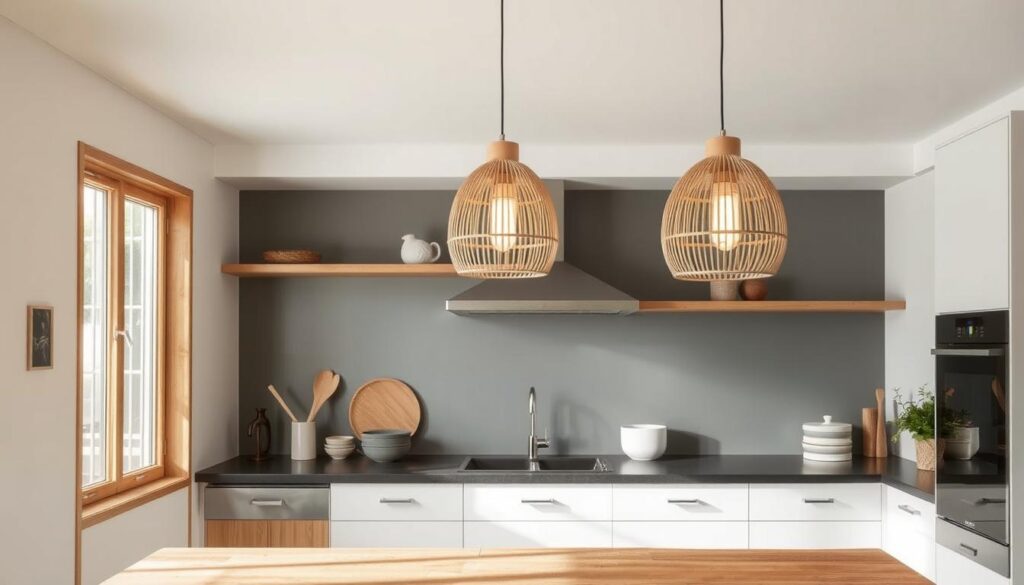
Lighting sets the mood in a Japandi kitchen. Choose pendant lights made from natural materials kitchen like wood or bamboo. They light up the space and add to the japanese-scandinavian fusion look.
Window Treatments that Fit the Aesthetic
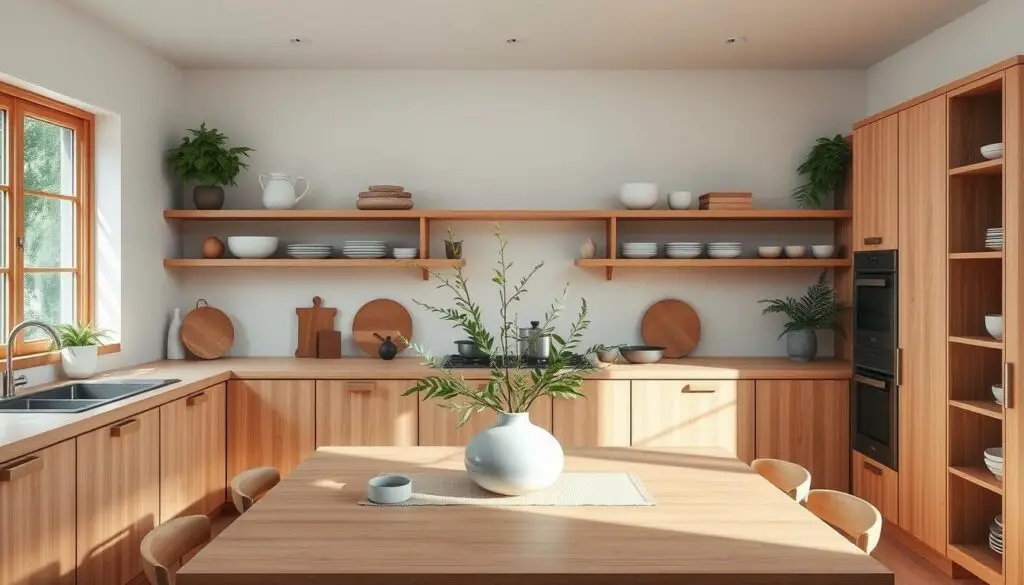
Window treatments in a Japandi kitchen should be simple. Shoji screens or linen curtains are great. They let in light, keep things private, and fit the zen-inspired interiors perfectly.
For a Japandi kitchen, pick decor that’s both beautiful and practical. Use natural materials, simple designs, and focus on simplicity. This way, you’ll have a kitchen that’s peaceful and reflects the Japandi style.
Incorporating Nature into Your Kitchen
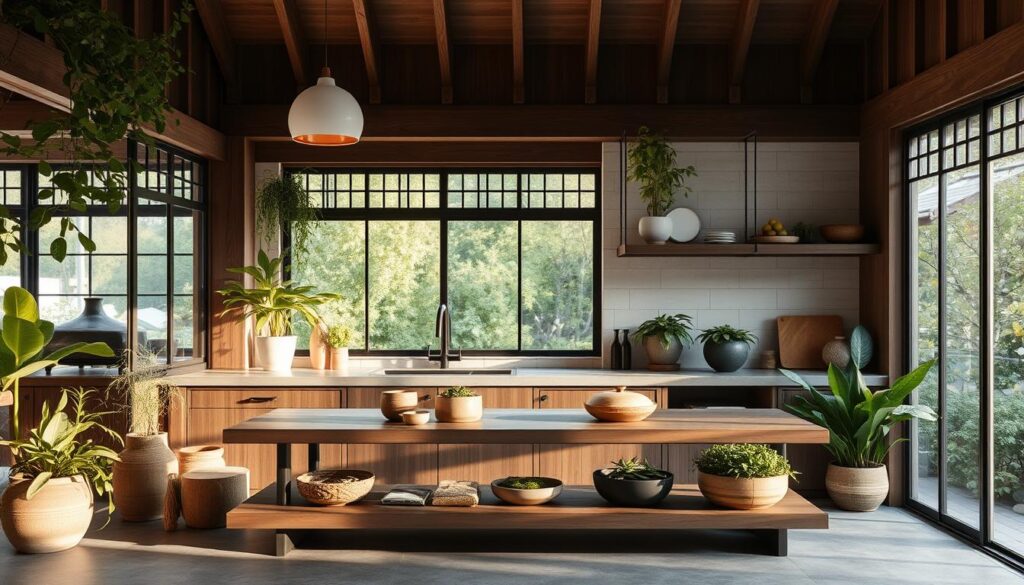
Embracing Japandi design means blending nature into your kitchen. This includes choosing plants and using natural light. These elements create a calm, zen-like atmosphere.
Plant Choices for a Serene Atmosphere
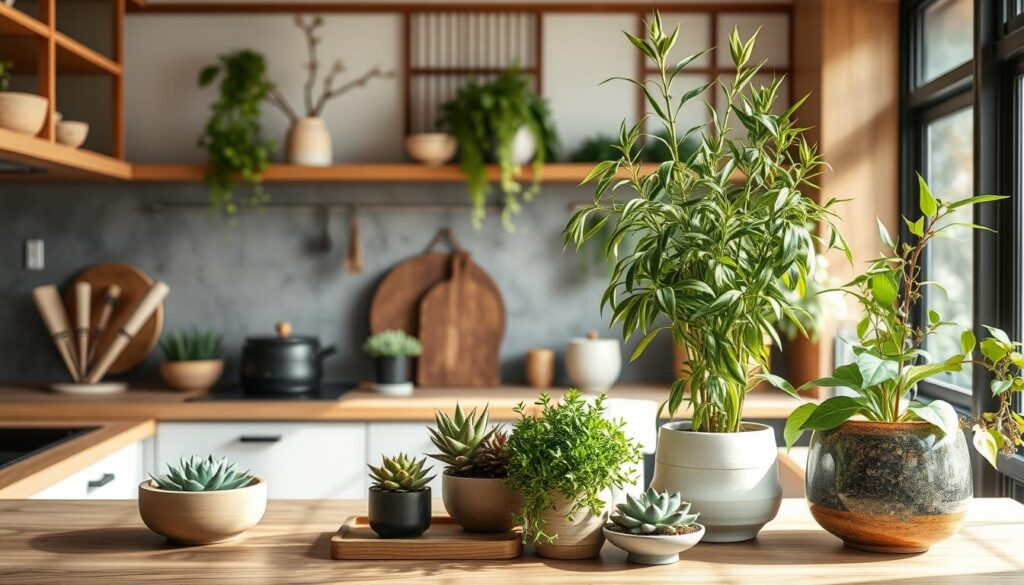
Plants are key in a Japandi kitchen. They purify the air and bring calm. Succulents, bamboo, and herbs like basil and thyme are great choices.
These plants make the kitchen look good and feel good too.
Natural Light: Importance and Ideas
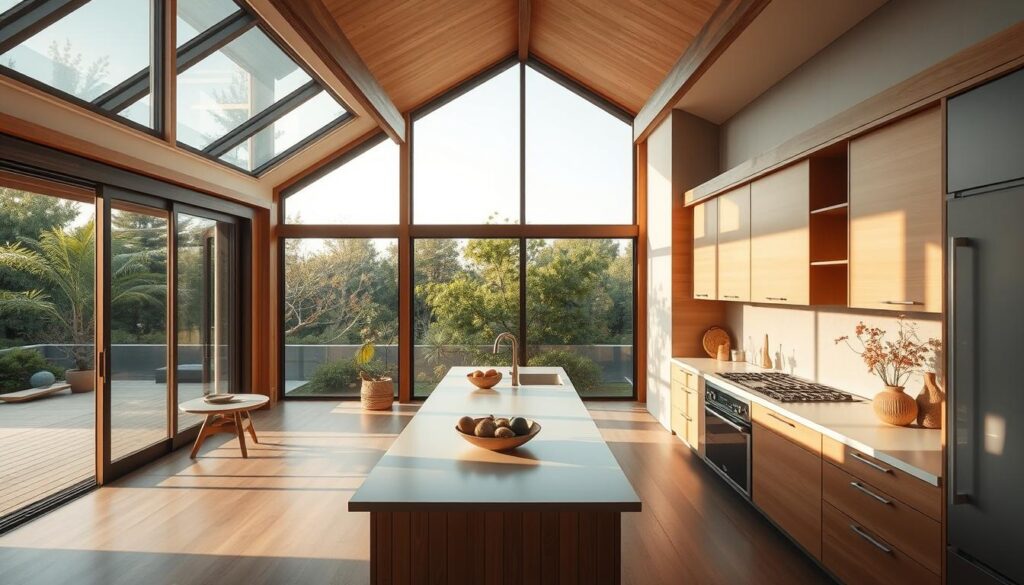
Natural light is crucial in Japandi kitchens. Big windows, skylights, or sliding doors bring in warmth and light. This makes the kitchen feel peaceful.
If light is scarce, use soft, warm lights. They mimic the outdoors’ cozy feel.
Herbal Gardens: Functional and Decorative
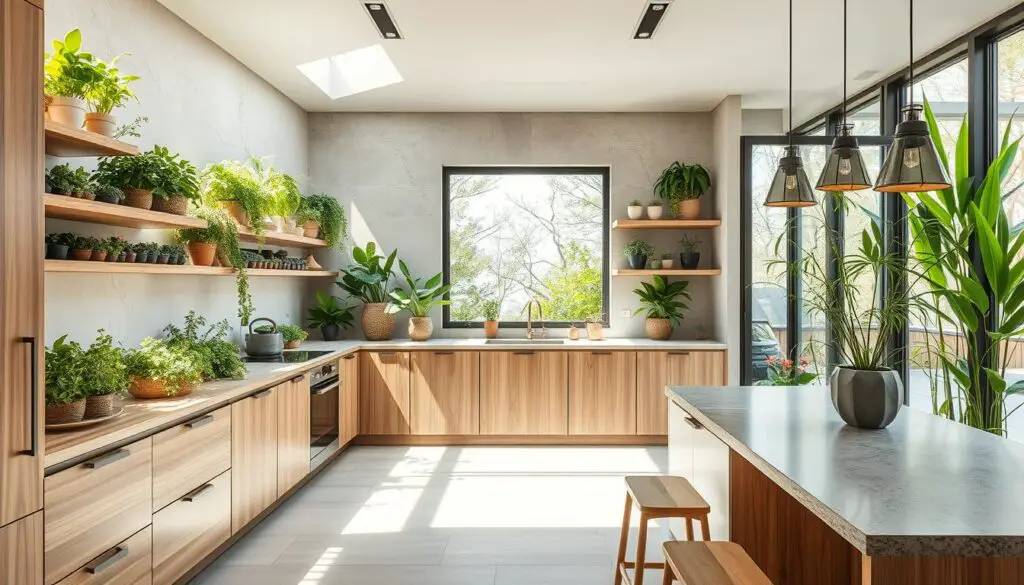
An herbal garden in your kitchen is both beautiful and useful. Potted herbs on the windowsill or a small planter add to the decor. They also give you fresh ingredients for cooking.
This mix of beauty and usefulness follows Japandi design’s philosophy.
By adding biophilic elements, zen-inspired touches, and sustainable ideas, you can make your kitchen a peaceful, nature-filled space. It will truly capture the spirit of Japandi design.
Storage Solutions for a Clutter-Free Space
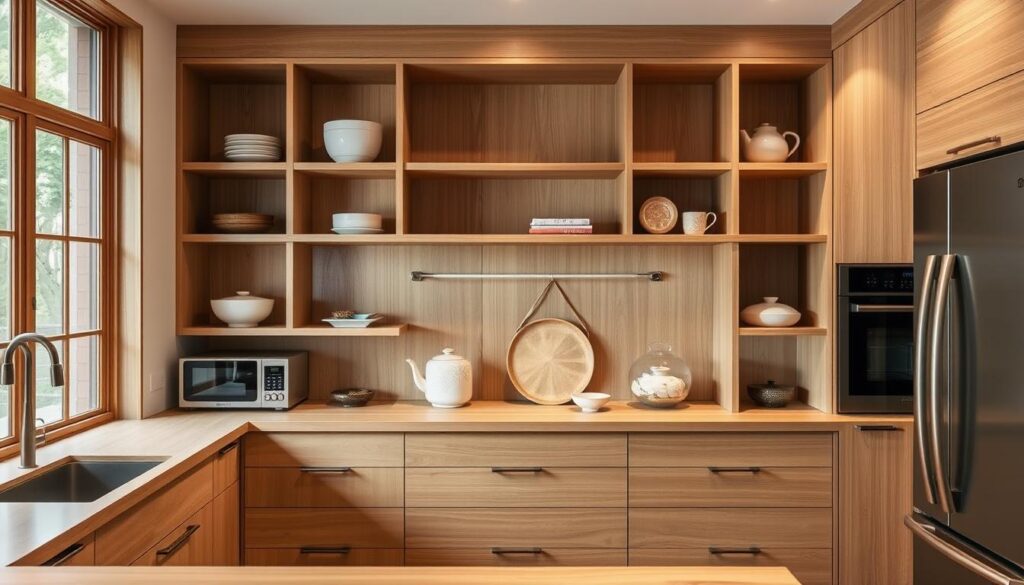
In a Japandi-inspired kitchen, keeping things simple and organized is key. Built-in shelving is a top choice for this. It maximizes space and fits well with the design. These shelves often have clean lines and use natural materials like wood or bamboo.
Hidden storage, like pull-out pantries or appliance garages, also helps. They keep countertops clear and add to the clean look.
Open shelving is used to show off a few special items. This follows Japandi’s simple and functional rules. By choosing what to display carefully, homeowners can keep their kitchen calm and tidy.
Built-In Shelving Ideas
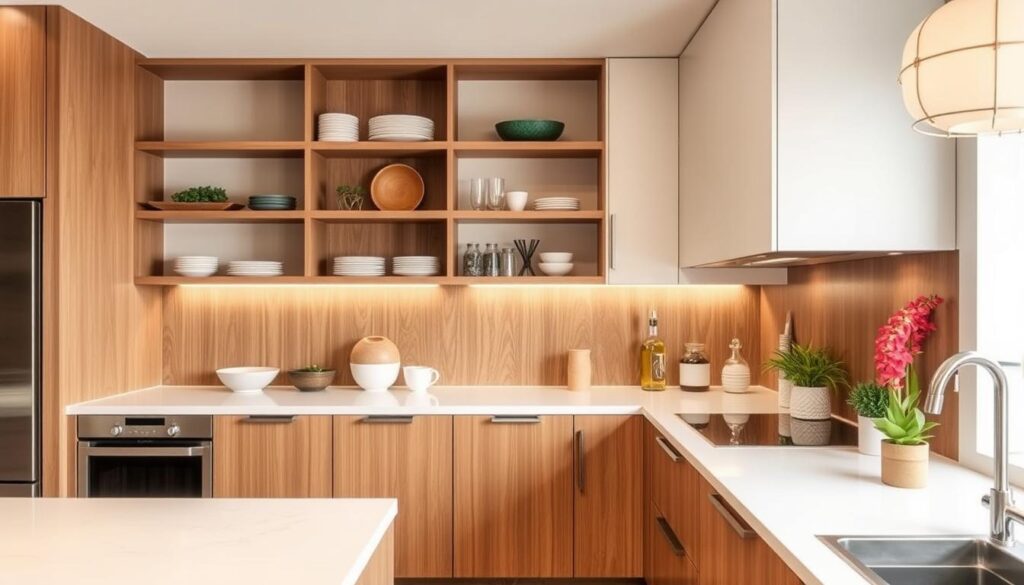
Built-in shelving is a big part of Japandi design. It offers lots of storage and looks good doing it. You can pick shelves that match your cabinets or go for something different, like bamboo, for a pop of color.
Hidden Storage Options
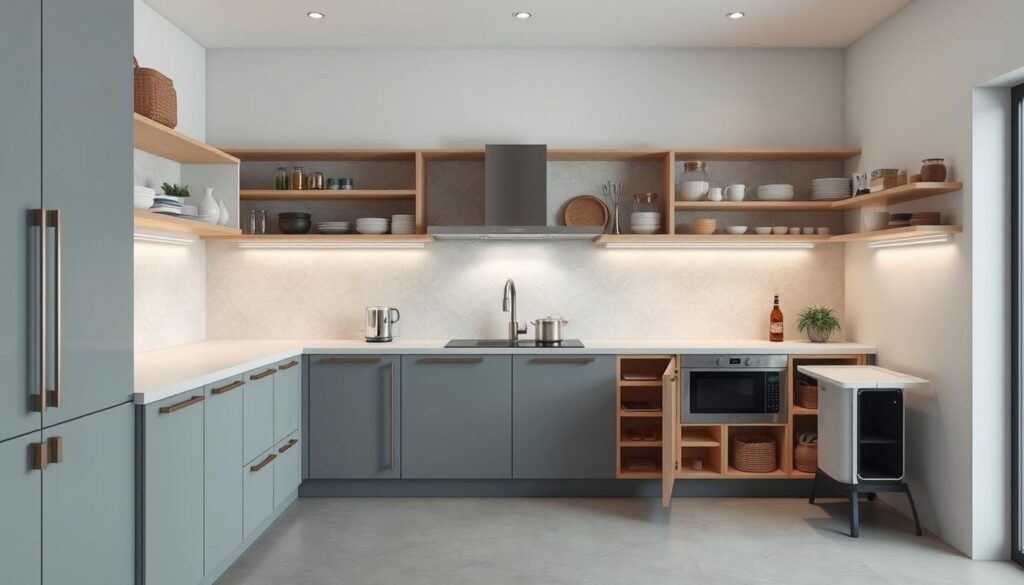
For a open shelving kitchen, Japandi design uses hidden storage. Pull-out pantries and appliance garages keep things tidy. They hide big items, keeping the kitchen balanced and focused on sustainability.
Open Shelving for Displaying Simplicity
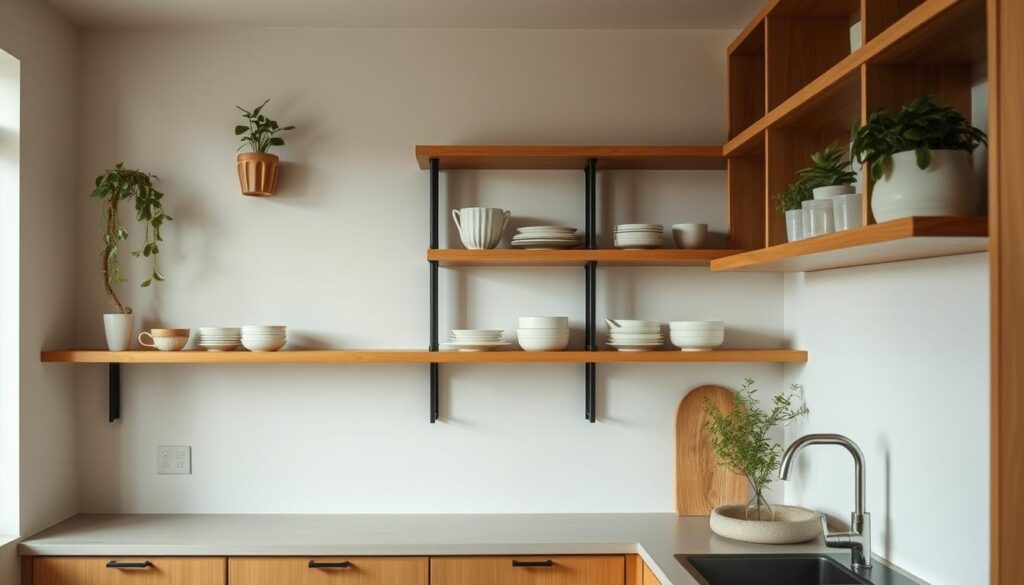
Open shelving is used carefully in Japandi kitchens. It’s for showing off a few chosen items, like ceramics or plants. The goal is to keep things simple, letting the beauty of the materials and space shine.
“In a Japandi kitchen, every item has its place, contributing to the overall sense of calm and order.”
Kitchen Islands in Japandi Design
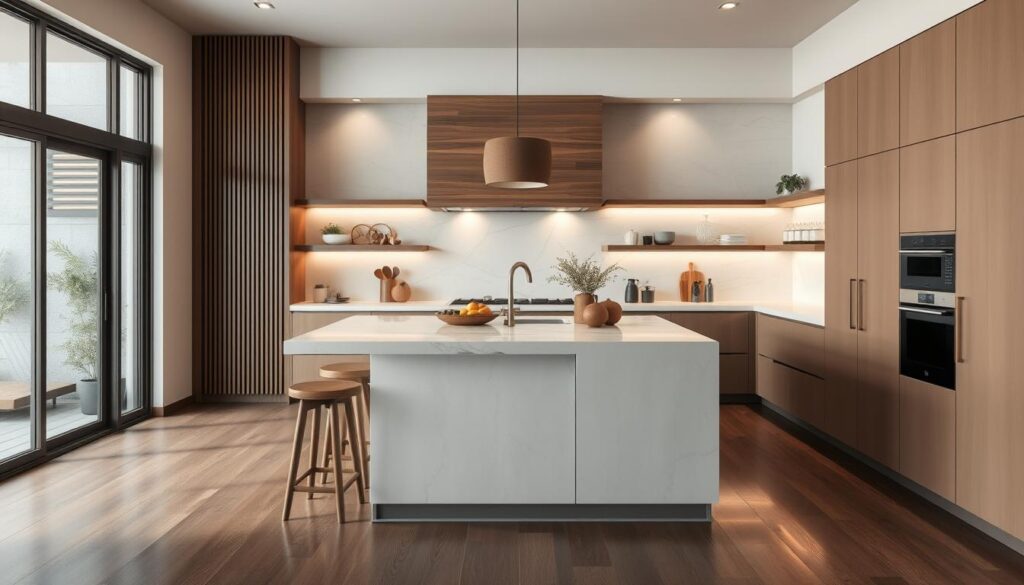
In Japandi kitchen design, the kitchen island is a key element. It combines style and practicality perfectly. These islands offer extra counter space and storage. They also act as a meeting spot, enhancing the kitchen’s flow.
Functionality Meets Style
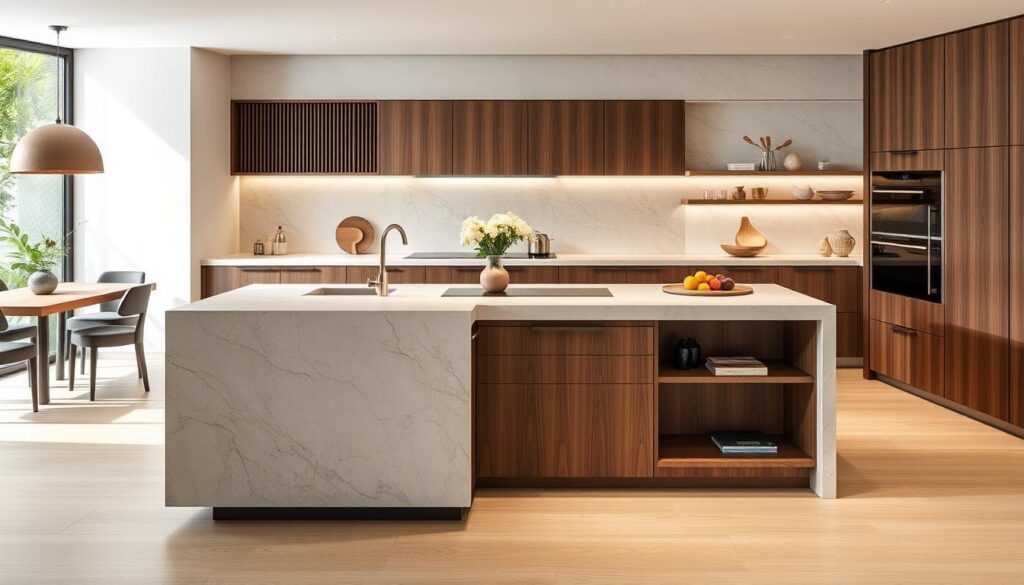
Japandi kitchen islands are designed to do many things. They have features like built-in sinks and cooktops. They also have lots of storage and seating, making them the kitchen’s center.
Material Choices for Kitchen Islands
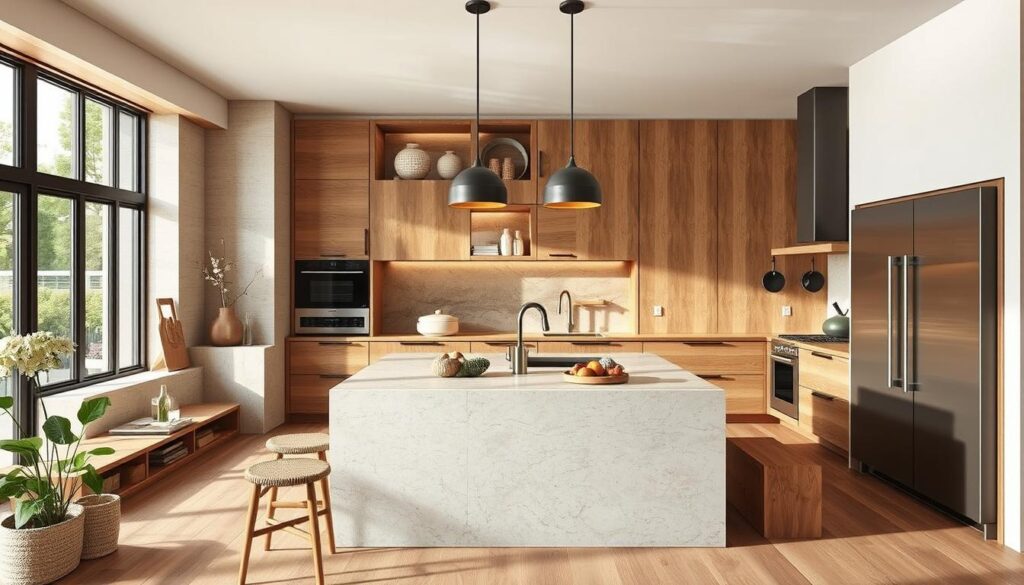
Kitchen islands in Japandi style often use wood and stone. These materials add warmth and texture. They fit well with the minimalist kitchen design and natural materials kitchen look, creating a cozy feel.
Creative Island Layout Ideas
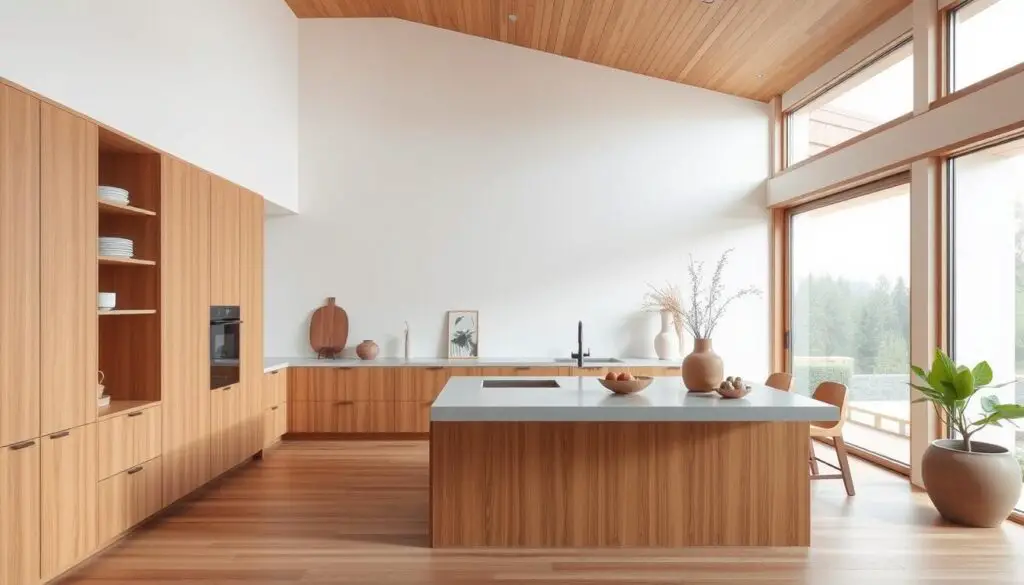
- Elongated islands with built-in seating or a breakfast bar for casual dining
- Islands with integrated sinks or cooktops to maximize functionality
- Islands with adjustable height or movable components for versatility
- Islands with open shelving or display areas for showcasing décor and greenery
Japandi kitchen islands have clean lines and simple shapes. They fit well with the kitchen’s look while adding important features.
Accessories to Enhance Your Japandi Kitchen
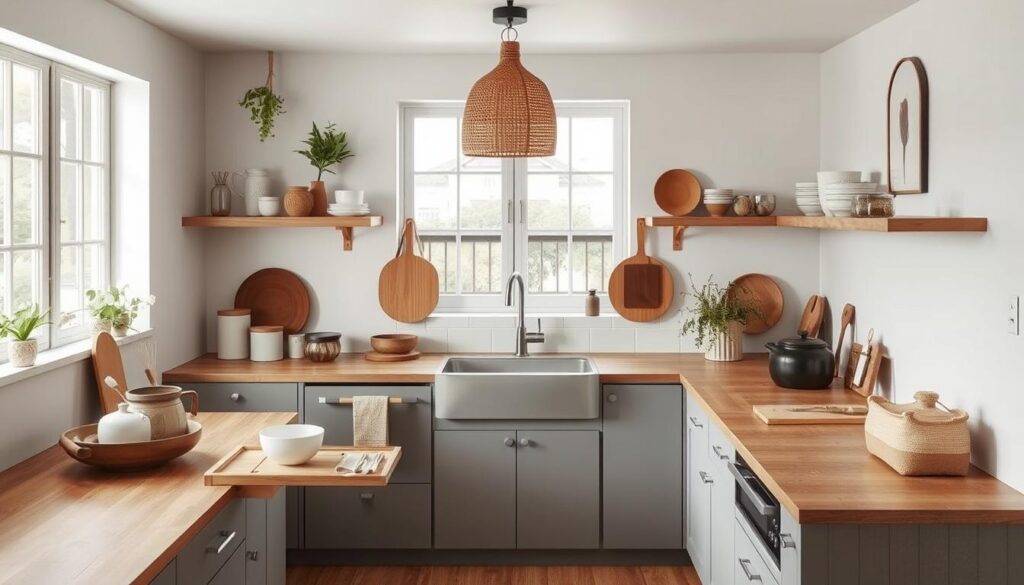
In a Japandi kitchen, accessories are chosen with care to add beauty without clutter. The focus is on being simple and functional, with a natural warmth. This complements the japanese-scandinavian fusion design. Each item, from cookware to decor, is picked to enhance the zen-inspired interiors and earth tones color palette.
Choosing the Right Cookware and Utensils
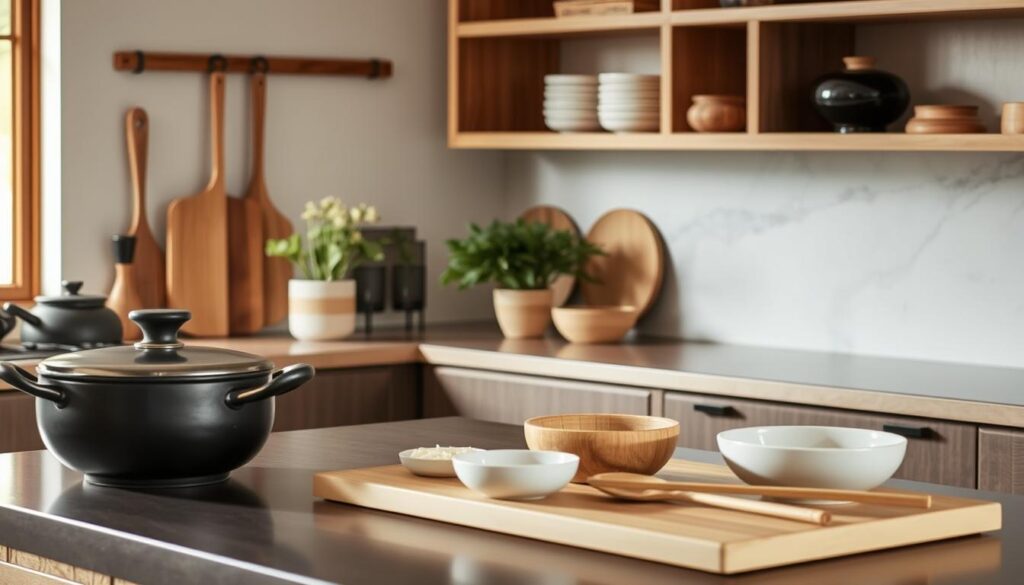
Japandi kitchens prefer cookware and utensils with clean lines and natural materials like wood or bamboo. These pieces look good and make the kitchen work better. Choose designs that fit well with the zen-inspired look.
Textiles that Add Warmth
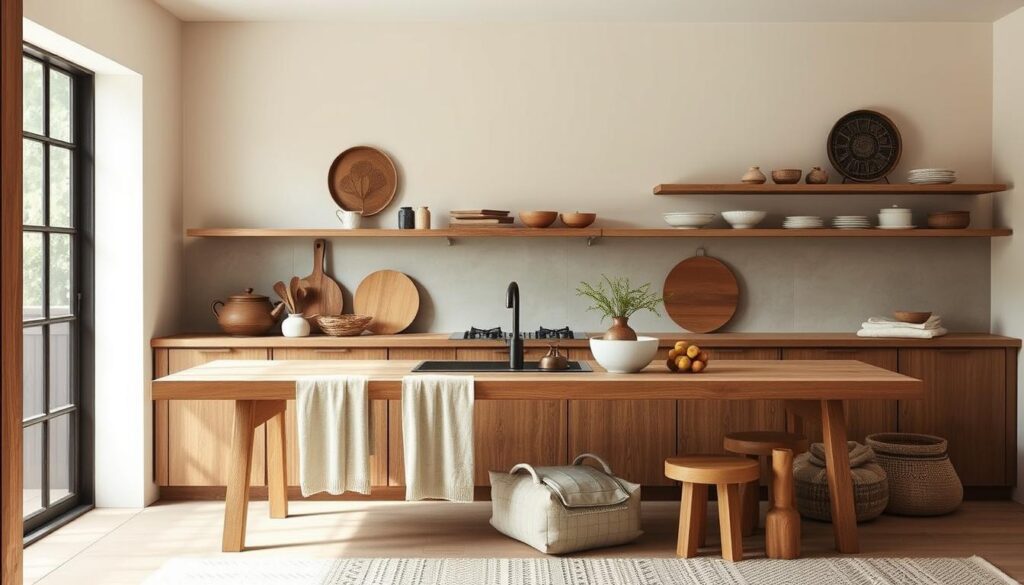
Textiles in a Japandi kitchen add warmth and texture, but are used sparingly. They are usually in neutral colors that match the earth tones color palette. Linen or cotton, like for towels or cushions, add a cozy feel without taking over.
Art and Decor that Complements the Space
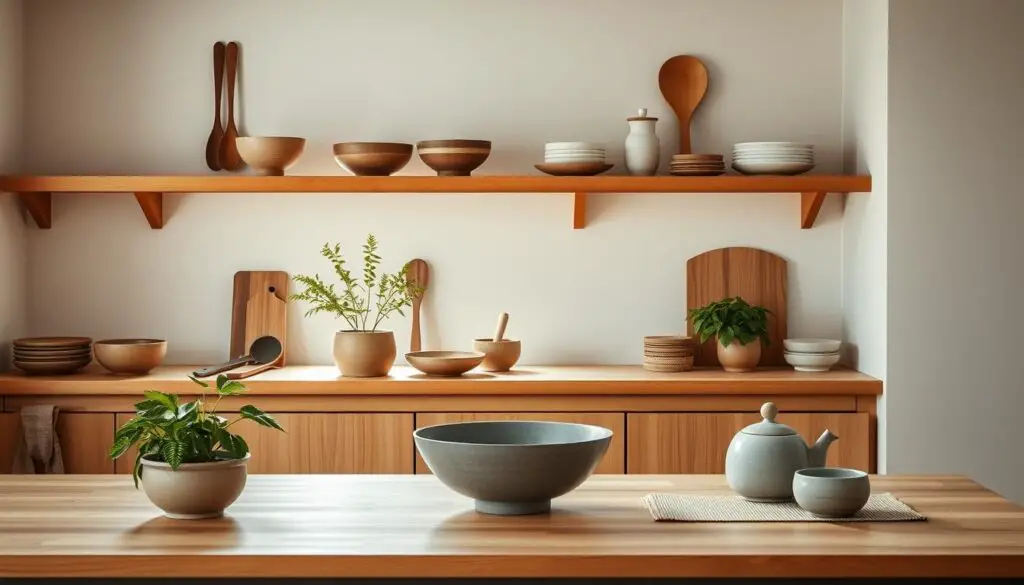
The art and decor in a Japandi kitchen are simple and aim to enhance the calm atmosphere. This might include pottery, minimalist art, or small plants. The goal is to create a unified look that celebrates the japanese-scandinavian fusion design.
| Accessory Type | Recommended Features |
|---|---|
| Cookware and Utensils | Clean lines, natural materials (wood, bamboo) |
| Textiles | Neutral colors, natural fibers (linen, cotton) |
| Art and Decor | Minimal, nature-inspired (pottery, artwork, plants) |
“The beauty of Japandi design lies in its ability to create a serene and functional space through the thoughtful selection of accessories.”
Achieving a Zen-Like Atmosphere
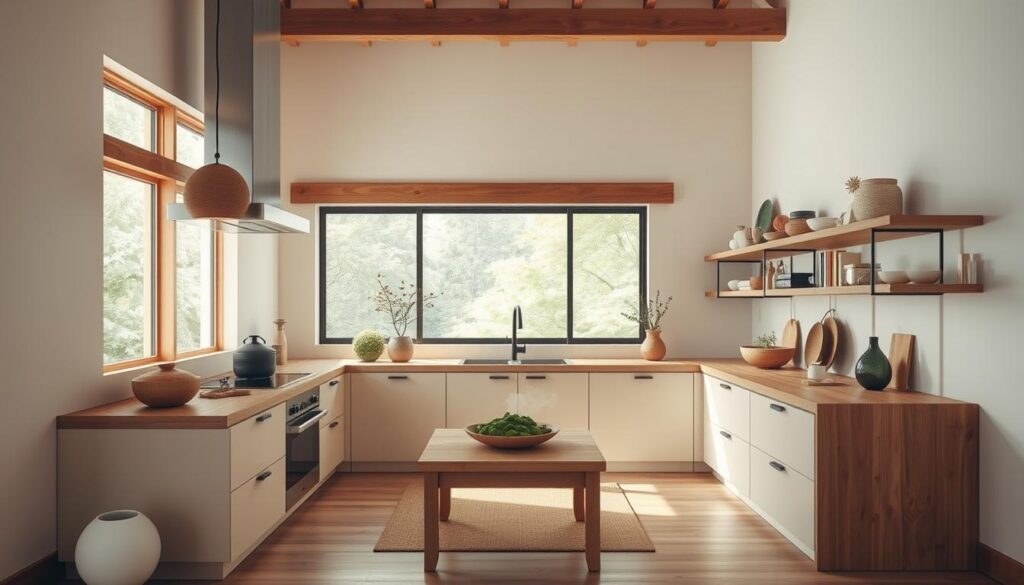
Japandi design brings a Zen-like feel to kitchens. It focuses on simplicity, minimalism, and a connection to nature. This creates a calm and focused space for cooking.
The Role of Simplicity in Japandi
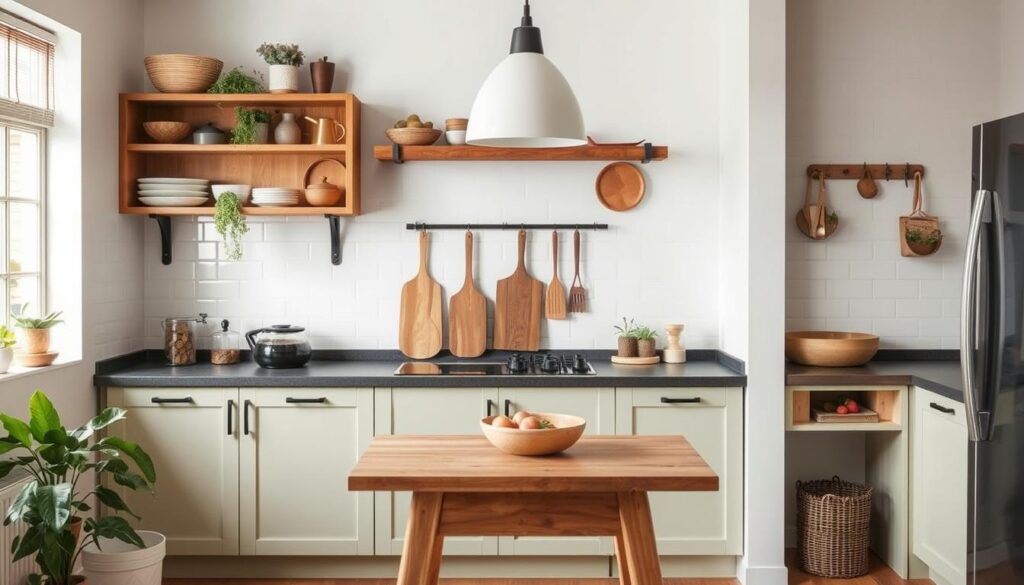
Japandi believes in the power of simplicity. It’s seen in clean lines, uncluttered spaces, and chosen decor. Every element in a Japandi kitchen has a purpose, from sleek cabinets to simple lighting.
This simplicity lets the beauty of materials shine. It promotes a peaceful and focused environment.
Mindful Cooking Spaces
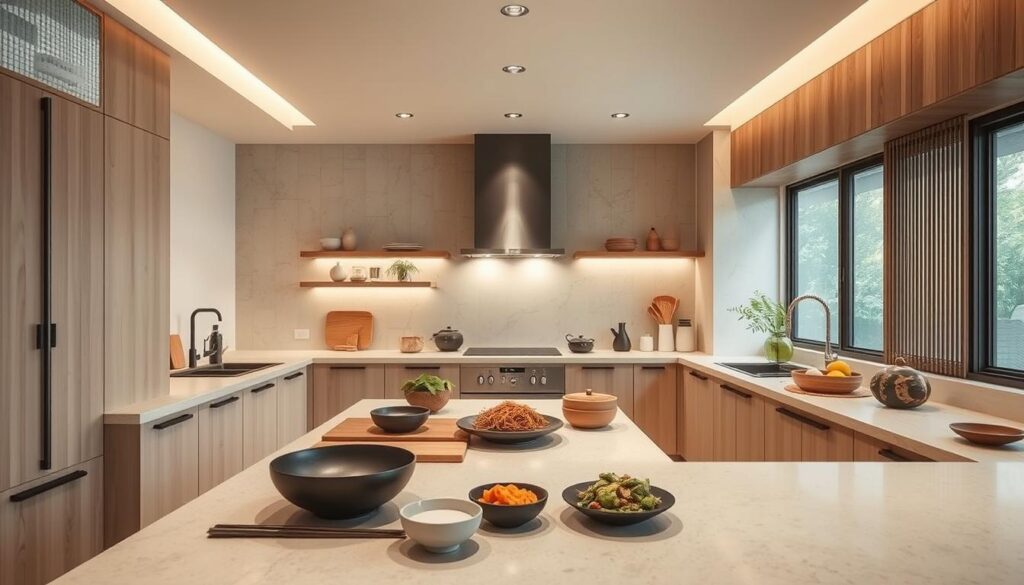
Japandi kitchens are designed for mindful cooking. They focus on function and organization. This makes cooking clear and controlled, keeping the chef fully present.
The minimalist design and natural materials enhance this calm. They create a space perfect for mindful meal prep.
Creating a Peaceful Cooking Environment
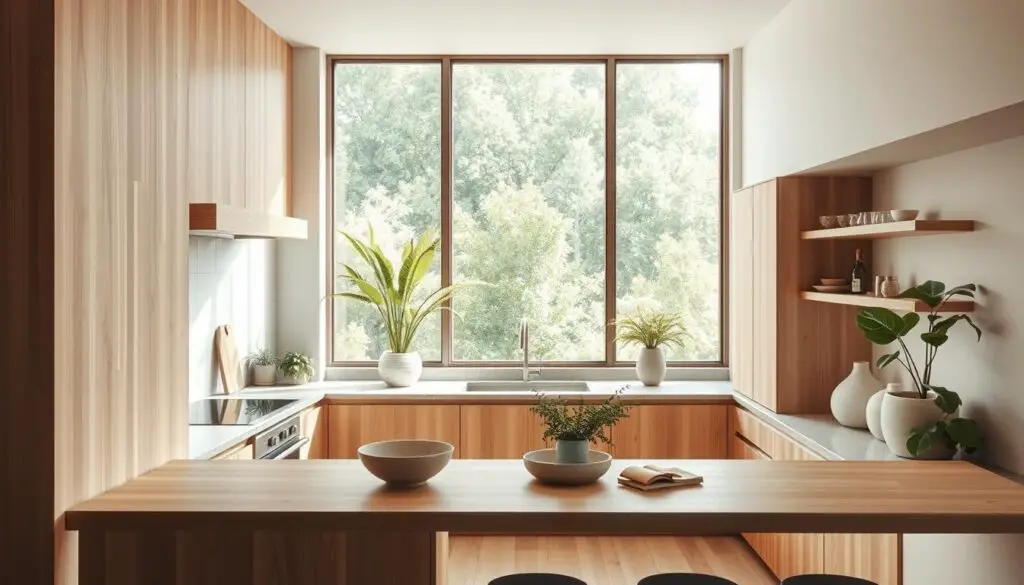
Japandi kitchens use biophilic design for calm. They include natural light, greenery, and earthy tones. Natural materials like wood and stone add warmth and texture.
The soft color palette of whites, grays, and pastels adds tranquility. This mix of minimalism and nature turns the kitchen into a peaceful oasis.
“The essence of Japandi design is to create a sanctuary-like kitchen that nourishes the senses and the soul.”
DIY Japandi Kitchen Projects
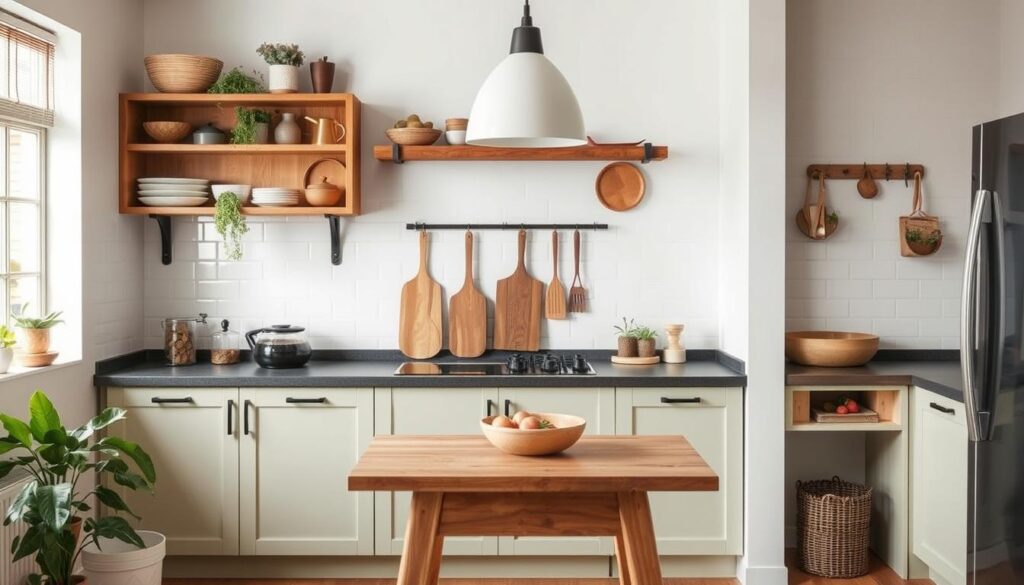
Making your own Japandi kitchen elements is rewarding and eco-friendly. You can add your personal touch with simple DIYs and upcycling. These projects keep your kitchen in line with sustainable kitchen concepts, natural materials, and a japanese-scandinavian fusion look.
Simple Crafts to Elevate Your Space
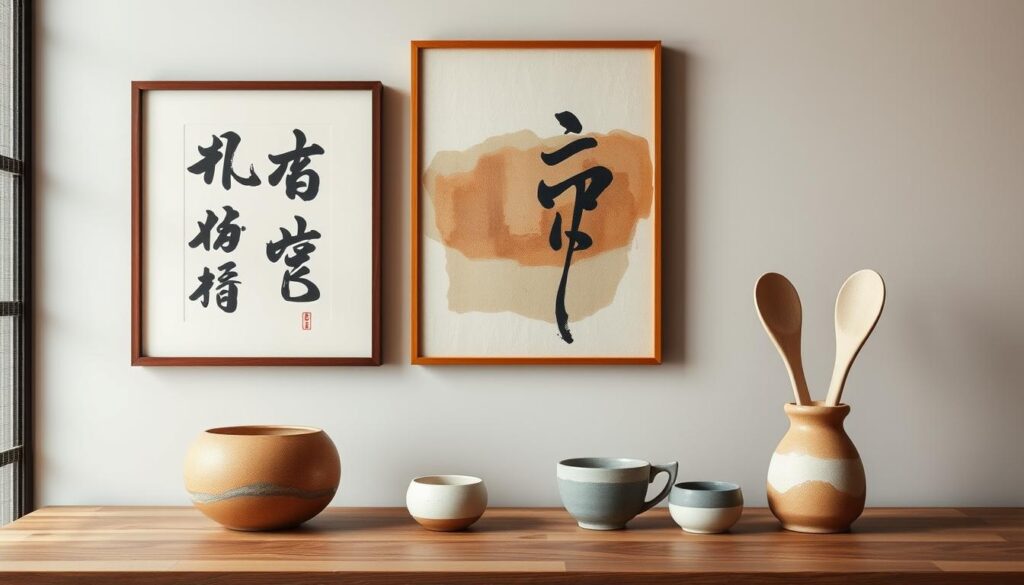
Japandi design loves handmade, artisanal pieces. Try making minimalist wall art like a framed calligraphy or an abstract painting in earthy tones. Handmade pottery, like sleek mugs or a ceramic utensil holder, adds a personal touch.
Upcycling Ideas for Sustainability
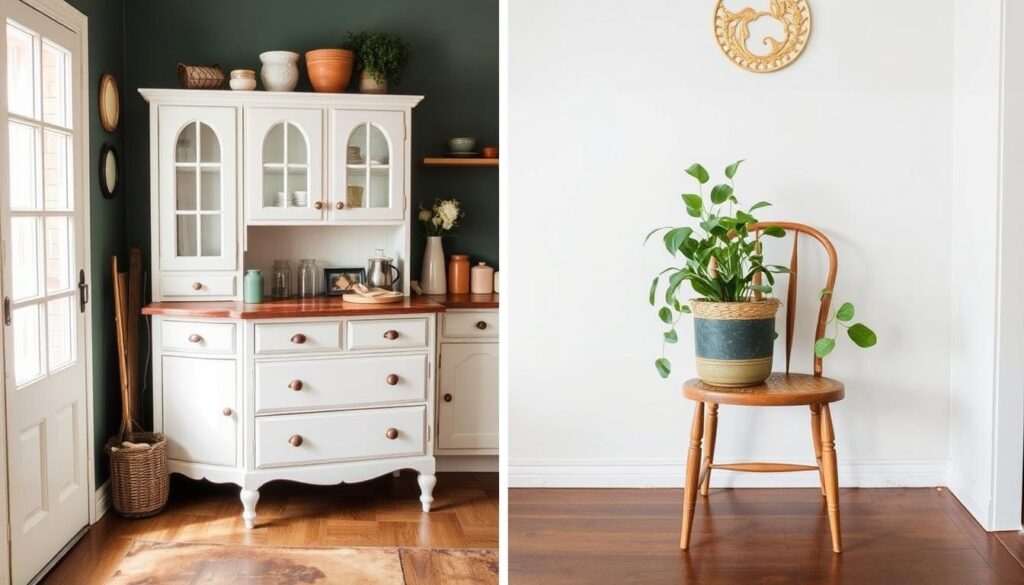
Upcycling old furniture or items is key to Japandi’s sustainability. Turn an antique dresser into a kitchen island with neutral paint, or make a unique plant stand from a worn chair. These projects cut waste and fit the Japandi look of mixing old and new.
Personalized Decor Touches
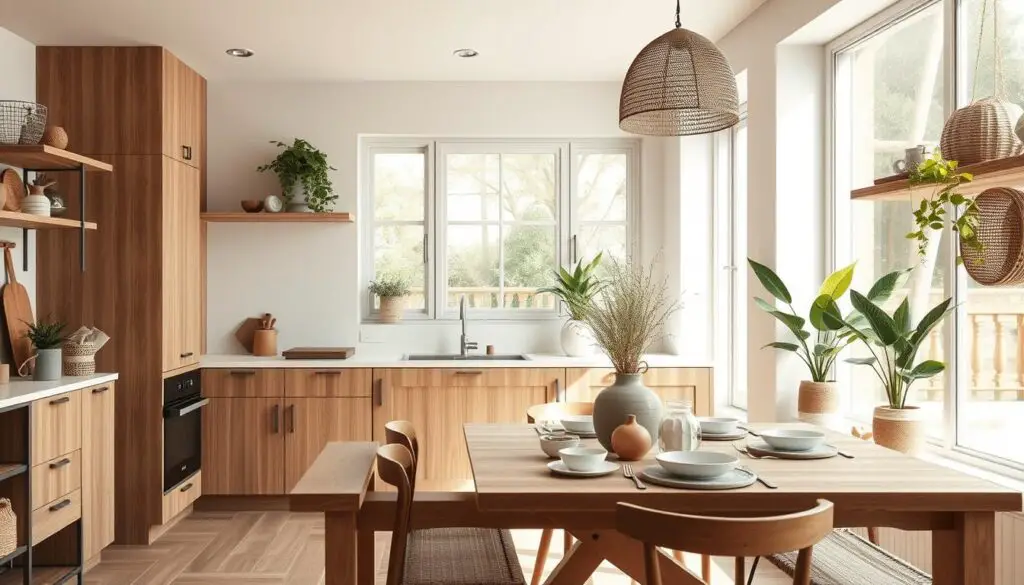
Japandi design is simple, but your kitchen can still show your style. Make custom storage like a minimalist spice rack or a hanging herb garden. Handmade textiles, like a linen table runner or elegant napkins, add coziness to your Japandi space.
DIY Japandi kitchen projects improve your space’s harmony and function. They let you add your unique touch. Focus on clean lines, natural materials, and a minimalist look that blends Japanese and Scandinavian styles.
Real-Life Examples of Japandi Kitchens
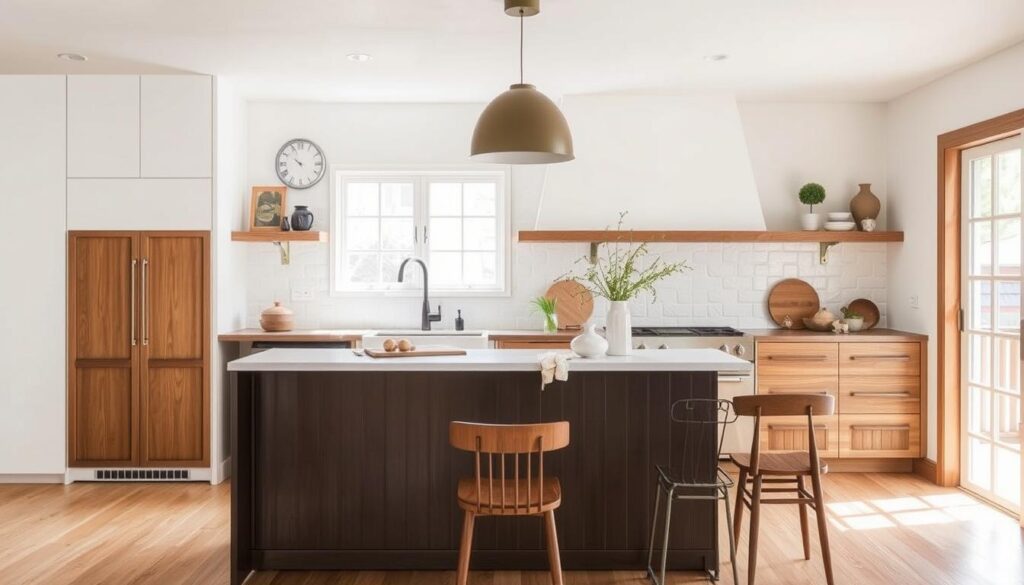
Real-life Japandi kitchens show how people and designers make this style work. They add unique touches that mix Japanese and Scandinavian styles. For example, they might use custom cabinet doors inspired by shoji screens or wooden countertops made by hand.
These kitchens prove Japandi’s flexibility. They show it can fit many tastes and spaces.
Design Lessons from Successful Kitchens
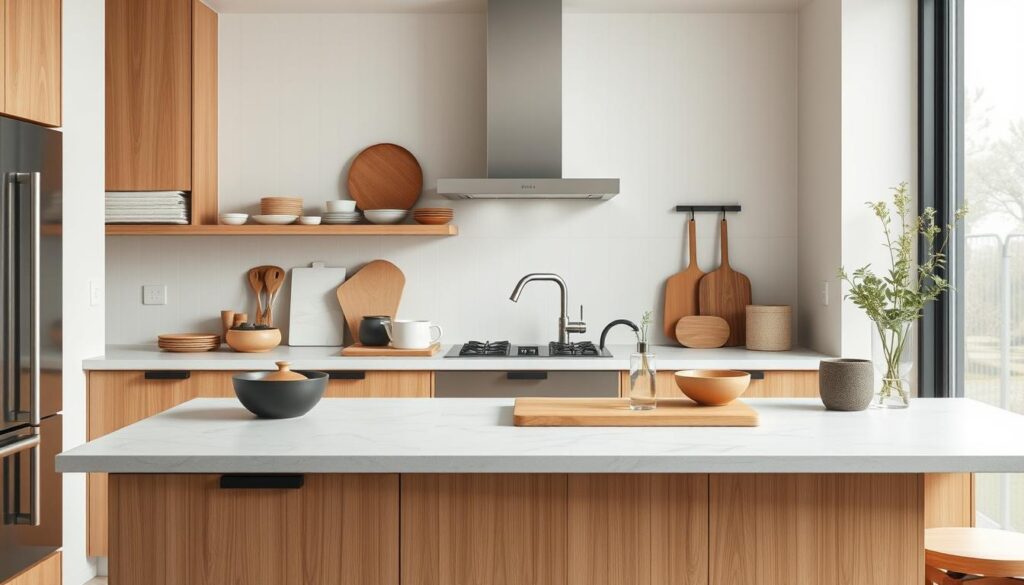
Successful Japandi kitchens teach us about balance and keeping things simple. They use smart storage like pull-out drawers and hidden spots. This keeps the space clean and functional for cooking and hosting.
Interviews with Japandi Enthusiasts
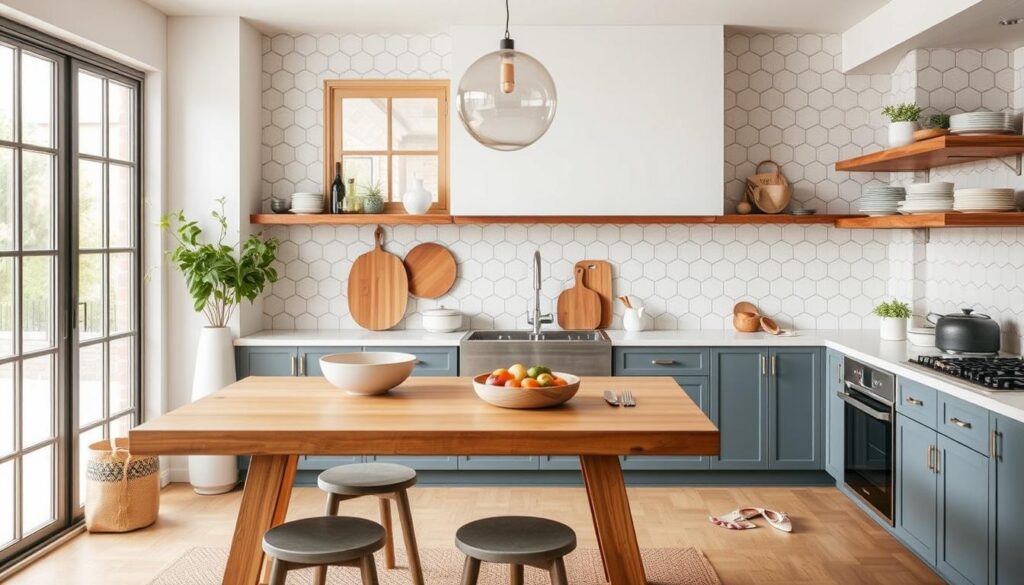
People who love Japandi share their experiences. They talk about keeping their kitchens calm and adding personal touches. Their stories show how Japandi can change a kitchen, focusing on simplicity and natural beauty.
More Japandi Kitchen Decor Ideas
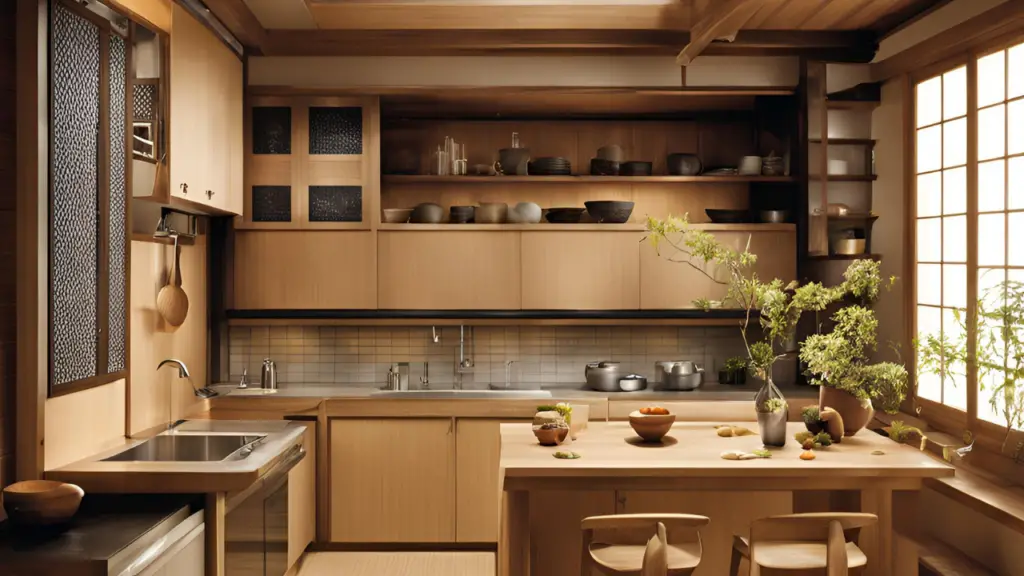
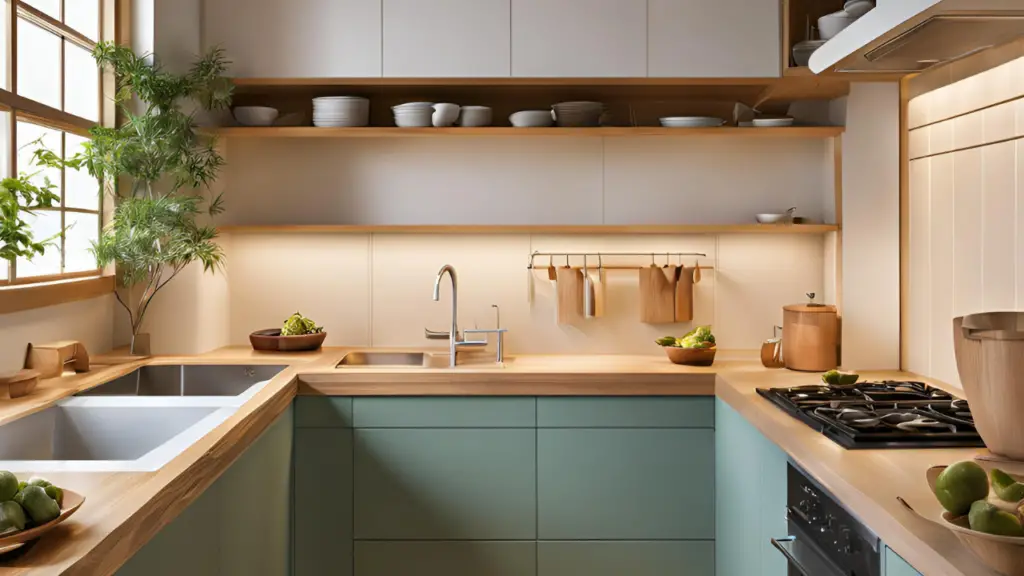
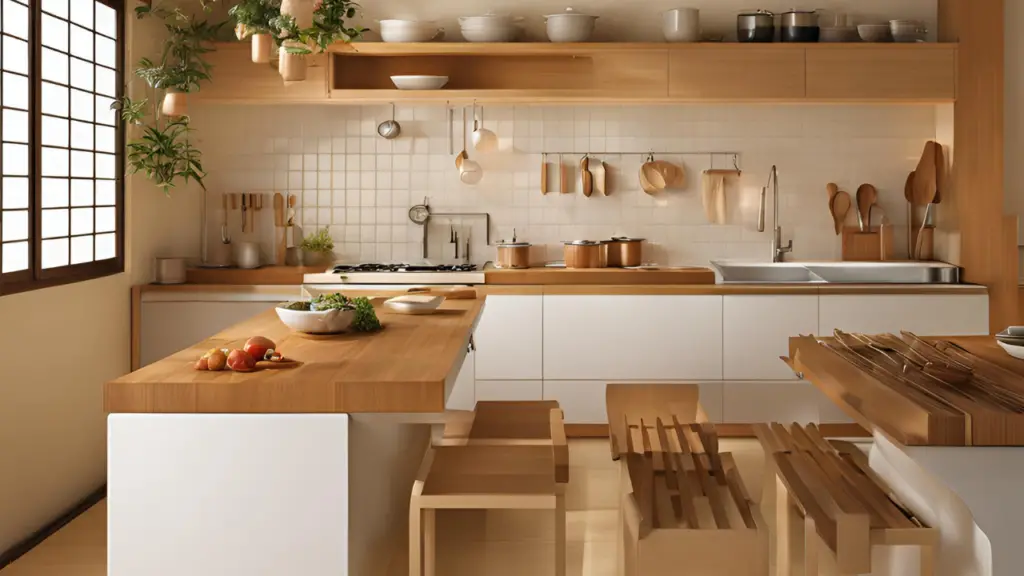
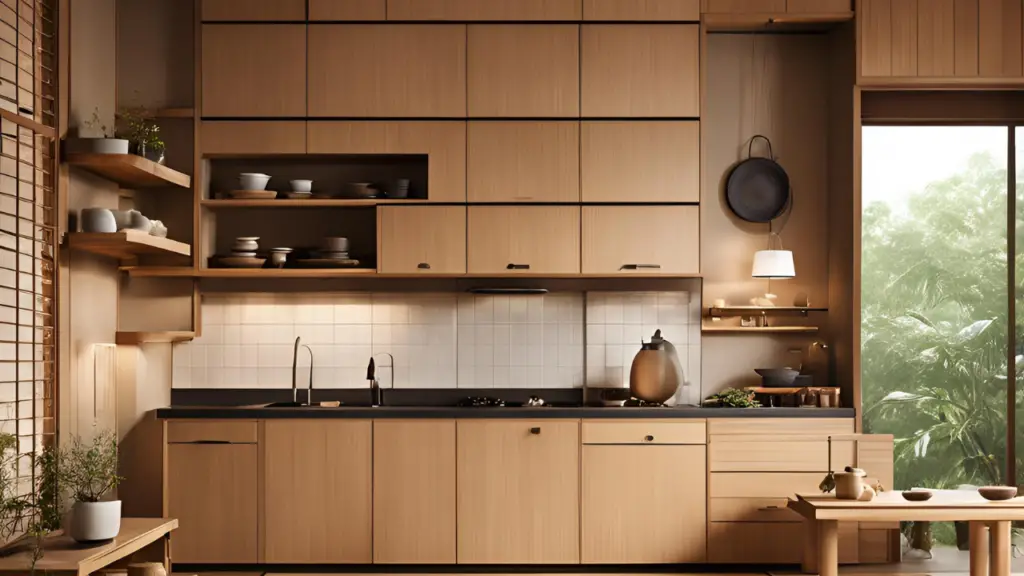

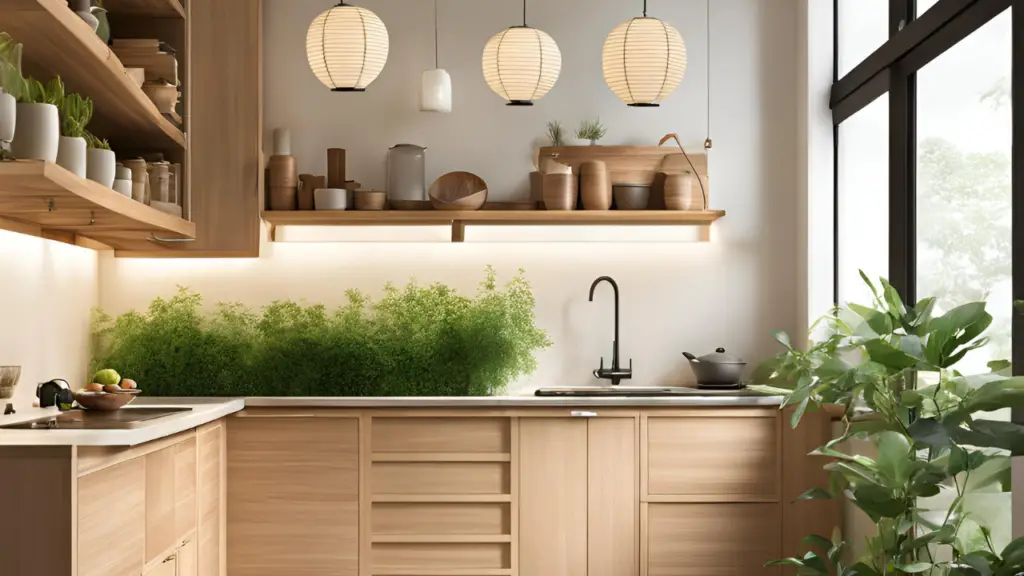
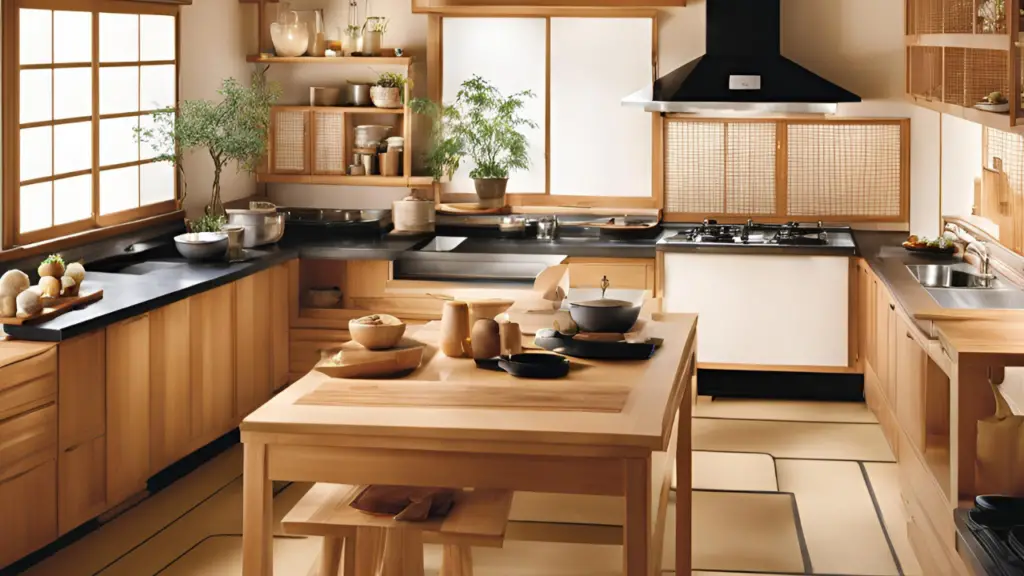
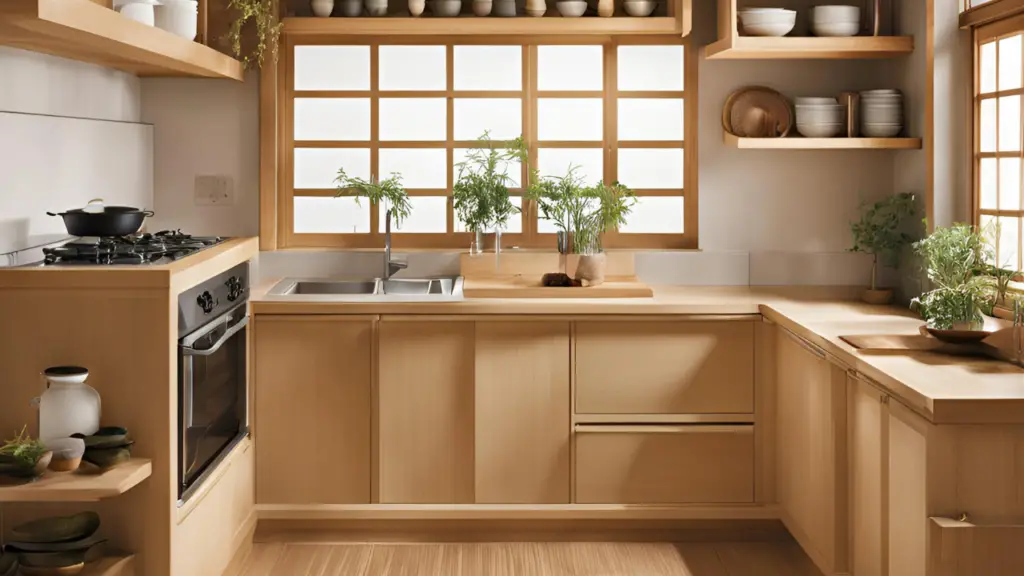
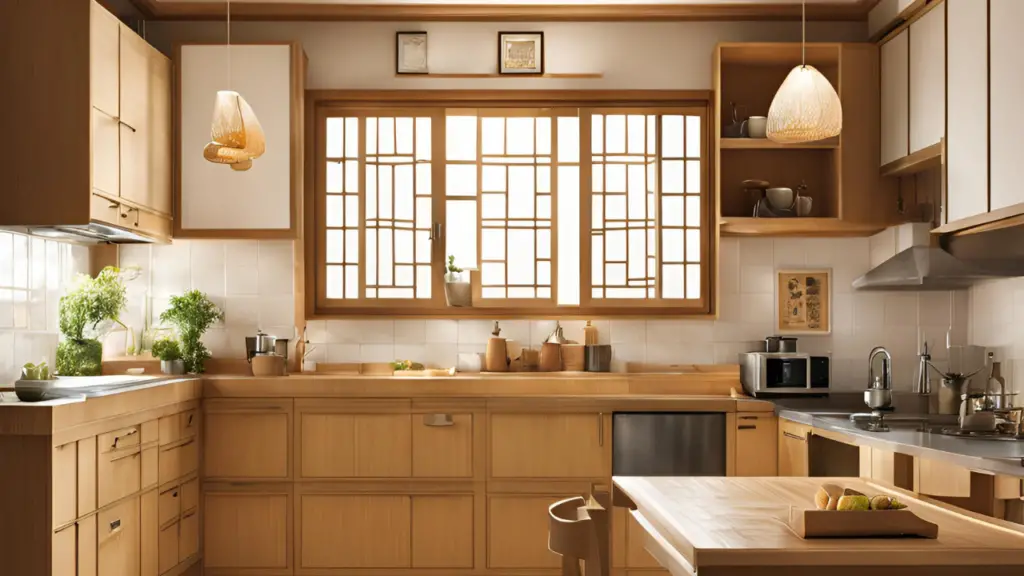
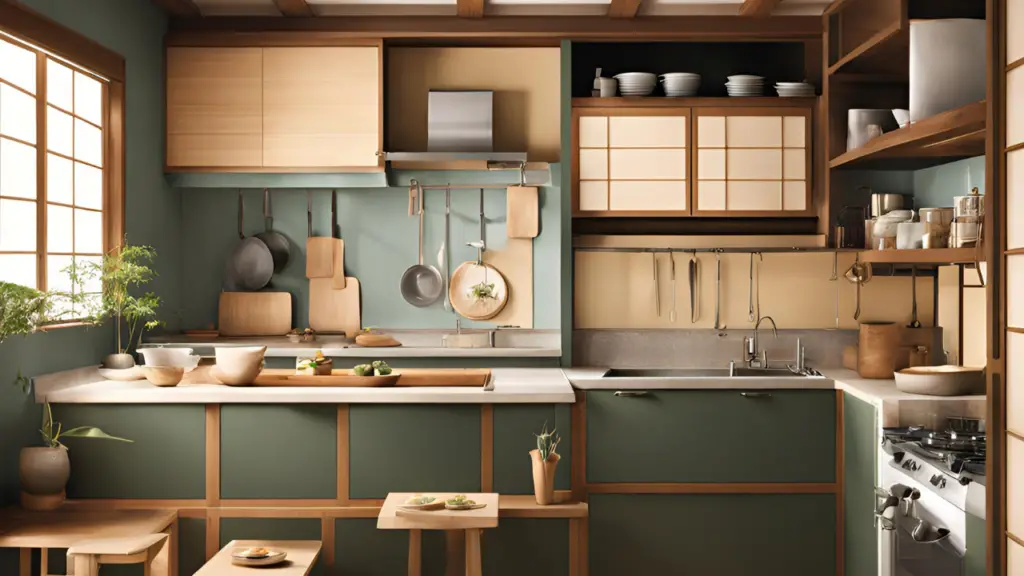
FAQ
What is Japandi style?
Japandi style combines Japanese and Scandinavian design. It values minimalism, functionality, and natural materials. It also emphasizes a connection to nature.
How does Japandi design balance aesthetics and functionality?
Japandi design aims for both beauty and practicality. It uses simplicity and clean lines. Natural materials like wood and bamboo add warmth and texture.
What color palettes are common in Japandi kitchens?
Japandi kitchens often use soft colors like whites, beiges, and greys. These colors create a calm atmosphere. They let natural materials stand out.
What are the key features of a Japandi kitchen?
Japandi kitchens are open and minimalist. They use natural materials like wood and bamboo. The design is simple, making the space feel airy and clean.
How do Japandi kitchens incorporate nature?
Japandi kitchens bring nature inside. They use plants for a peaceful feel. Natural light and herbal gardens are also key.
What kind of storage solutions are common in Japandi kitchens?
Japandi kitchens keep things tidy. They use built-in shelving and hidden storage. Open shelving is used to display a few chosen items.
How do Japandi kitchen islands blend functionality and style?
Japandi kitchen islands are practical and stylish. They offer counter space, storage, and seating. They’re made from natural materials like wood or stone.
What kind of accessories are used in a Japandi kitchen?
Japandi kitchens have carefully chosen accessories. They include cookware and utensils with clean lines. Textiles and decor pieces add to the calm atmosphere.
How can a DIY project help personalize a Japandi kitchen?
DIY projects can make a Japandi kitchen unique. You can create minimalist art, repurpose furniture, or make storage solutions. Handmade textiles also add a personal touch.
What can we learn from real-life examples of Japandi kitchens?
Real Japandi kitchens show how to mix Japanese and Scandinavian styles. They offer design tips and insights. Interviews with enthusiasts share how to keep the space serene and add personal touches.

